Lou’s Views
News & Views / June Edition
Calendar of Events –

Riverfest Celebration
June 29th
Conway SC
Held along the Waccamaw River in downtown Conway the festival celebrates Independence Day since 1980 with music and events for the entire family.
For more information » click here

N.C. 4th of July Festival
July 4th
Southport
The patriotic spirit of America is alive and well in the City of Southport. For over 200 years this small maritime community has celebrated our nation’s independence in a big way. Incorporated as the N.C. 4th of July Festival in 1972 the festival committee strives to keep the focus of the festival on honoring our nation’s birthday with a little fun thrown in.
For more information » click here

Battleship Blast 4th of July Celebration
July 4th
Wilmington
.
.
Annual 4th of July Celebration at Riverfront Park in downtown Wilmington since 1981. Featured entertainment will perform from 6:00 PM to 9:00 PM, followed by fireworks at 9:05 PM launched from a barge in the Cape Fear River adjacent to the USS North Carolina Battleship. The only place you need to be this holiday is downtown Wilmington for the best view of fireworks.
For more information » click here
 Discover a wide range of things to do in the Brunswick Islands for an experience that goes beyond the beach.
Discover a wide range of things to do in the Brunswick Islands for an experience that goes beyond the beach.
For more information » click here.
Calendar of Events Island –

The Chapel Choir July 4th Patriotic Musical Performance
The Holden Beach Choir is putting on a July 4th holiday concert. On Saturday June 29th at 7:00 pm, the choir will present the musical Salute to America, accompanied by an instrumental ensemble.

Concerts on the Coast Series
The Town’s summer concert series calendar has been released! Live performances featuring local musical groups will temporarily be held at the Bridgeview Park picnic pavilion on Sunday evenings from late May to early September. The concerts are free of charge.
For more information » click here
The park will be blocked from vehicular access beginning Saturday evening. The splash pad will be closed on Sundays and the multipurpose court will close at 3:00 p.m. each Sunday. No seating will be provided so everyone should bring their own chair for the event.

Tide Dyed Program
The Tide Dye program will be held on Tuesdays between 1:00 to 2:30 p.m. at Bridgeview Park picnic pavilion. Participants must be in line by 2:00 p.m. to participate because the process takes approximately 30 minutes to complete. Fee is $7 per shirt for youth sizes through Adult XL and $10 per shirt for 2XL. Payment via cash or check only.
.Beginning June 11th and continuing through August 13th
 Turtle Talk
Turtle Talk
Two programs both are held every Wednesday during the summer at Town Hall. Children’s Turtle Time is at 4:00 p.m. with crafts, stories and activities for children ages 3 – 6. All children must be accompanied by an adult. Turtle Talk is an educational program at 7:00 p.m. for everyone else. (Beginning June 19th)

Summer Day Camp Program
The Town of Holden Beach will hold summer day camps on the following dates:
Thursday, July 18th –
Putterin Around – Join us for putt-putt and ice cream at Fantasy Isle. $12 resident/$17 non-resident; ages 6-12; 10:30 a.m.-noon. Drop off and pick up at Fantasy Isle.
Thursday, July 25th –
Sliding through Summer @ Magic Mountain Waterslide- $25 resident; $30 non-resident; ages 6-12; 10:00 a.m.-noon. Drop off and pick up at waterslide.
Thursday, August 1st –
Fun in Color Art Camp $10 resident/$15 non-resident; ages 6-12; 9:00 a.m.-noon at Town Hall
Thursday, August 15th –
Schools Almost Back Bash at the Splash Pad and Holiday A Polloza – We will briefly revisit holidays celebrated throughout the year with some fun games and end the day with a party at the splash pad. $10 resident/$15 non-resident; ages 6-12; 9:00 a.m. to noon at Town Hall
Register by emailing Christy at christy.ferguson@hbtownhall.com.
Parks & Recreation / Programs & Events
For more information » click here
Reminders –
 THB Newsletter (03/30/24)
THB Newsletter (03/30/24)
Paid Parking
Paid parking will be enforced starting April 1st in all Holden Beach designated parking areas. It will be enforced from 9:00 a.m. – 5:00 p.m. daily, with free parking before and after that time. All parking will use license plates for verification.
As a reminder, Holden Beach uses the “SurfCAST by Otto” parking solution. Annual passes are now available for purchase on the mobile app. You will also be able to purchase passes by scanning the QR-codes located on the parking signs for access to https://surfcast.ottoconnect.us/pay.
Rates for the 2024 season are as follows:
$5 per hour for up to four hours
$20 per day and for any duration greater than four hours
$80 per week (seven consecutive days)
$175 per calendar year for a single vehicle (annual passes)
Handicap parking is free in designated handicap spaces and only with a valid license plate or hangtag.
Parking rates can be paid via credit card, debit card or PayPal.
Visit https://hbtownhall.com/paid-parking for more information and to view a table with authorized parking areas.
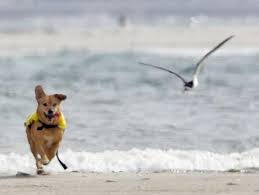
Pets on the Beach Strand
Pets – Chapter 90 / Animals / 90.20
From May 20th through September 10th it is unlawful to have any pet on the beach strand during the hours of 9:00am through 5:00pm.

Solid Waste Pick-Up Schedule
GFL Environmental change in service, trash pickup will be twice a week.Starting the Saturday before Memorial Day through the Saturday after Labor Day: Pick-up is every Tuesday and Saturday from May 25th through September 30th
Please note:
. • Trash carts must be at the street by 6:00 a.m. on the pickup day
. • BAG the trash before putting it in the cart
. • Carts will be rolled back to the front of the house
GFL Refuse Collection Policy
GFL has recently notified all Brunswick County residents that they will no longer accept extra bags of refuse outside of the collection cart. This is not a new policy but is stricter enforcement of an existing policy. While in the past GFL drivers would at times make exceptions and take additional bags of refuse, the tremendous growth in housing within Brunswick County makes this practice cost prohibitive and causes drivers to fall behind schedule.
Solid Waste Pick-up Schedule –
starting the Saturday before Memorial Day (May 25th) twice a week
Recycling –
starting after Memorial Day (June 4th) weekly pick-up
Curbside Recycling – 2024
GFL Environmental is now offering curbside recycling for Town properties that desire to participate in the service. The service cost per cart is $106.88 annually paid in advance to the Town of Holden Beach. The service consists of a ninety-six (96) gallon cart that is emptied every other week during the months of October – May and weekly during the months of June – September.
Curbside Recycling Application » click here
Curbside Recycling Calendar » click here

Trash Can Requirements – Rental Properties
GFL Environmental – trash can requirements
Ordinance 07-13, Section 50.08
Rental properties have specific number of trash cans based on number of bedrooms.
* One extra trash can per every 2 bedrooms
..
§ 50.08 RENTAL HOMES.
(A) Rental homes, as defined in Chapter 157, that are rented as part of the summer rental season, are subject to high numbers of guests, resulting in abnormally large volumes of trash. This type of occupancy use presents a significantly higher impact than homes not used for summer rentals. In interest of public health and sanitation and environmental concerns, all rental home shall have a minimum of one trash can per two bedrooms. Homes with an odd number of bedrooms shall round up (for examples one to two bedrooms – one trash can; three to four bedrooms – two trash cans; five – six bedrooms – three trash cans, and the like).
Building Numbers
Ocean front homes are required to have house numbers visible from the beach strand.
Please call Planning and Inspections Department at 910.842.6080 with any questions.
§157.087 BUILDING NUMBERS.
(A) The correct street number shall be clearly visible from the street on all buildings. Numbers shall be block letters, not script, and of a color clearly in contrast with that of the building and shall be a minimum of six inches in height.
(B) Beach front buildings will also have clearly visible house numbers from the strand side meeting the above criteria on size, contrast, etc. Placement shall be on vertical column supporting deck(s) or deck roof on the primary structure. For buildings with a setback of over 300 feet from the first dune line, a vertical post shall be erected aside the walkway with house numbers affixed. In all cases the numbers must be clearly visible from the strand. Other placements may be acceptable with approval of the Building Inspector.
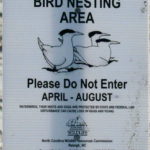 Bird Nesting Area
Bird Nesting Area
NC Wildlife Commission has posted signs that say – Bird Nesting Area / Please don’t disturb. The signs are posted on the west end beach strand around 1335 OBW.
.
People and dogs are supposed to stay out of the area from April through November
. 1) It’s a Plover nesting area
. 2) Allows migrating birds a place to land and rest without being disturbed

A Second Helping
.
Program to collect food Saturday mornings (8:00am to 10:30am) during the summer at the Beach Mart on the Causeway.
1) Twentieth year of the program
2) Food collections have now exceeded 298,000 pounds
3) Collections will begin on Memorial Day weekend
4) Food is distributed to the needy in Brunswick County
For more information » click here
.
Hunger exists everywhere in this country; join them in the fight to help end hunger in Brunswick County. Cash donations are gratefully accepted. One hundred percent (100%) of these cash donations are used to buy more food. You can be assured that the money will be very well spent.
Mail Donations to:
A Second Helping
% Sharon United Methodist Church
2030 Holden Beach Road
Supply, NC 28462
Storm Events –

Hurricane Vehicle Decals
Property owners will be provided with four (4) decals which were included in their April water bills. It is important that you place your decals in your vehicle or in a safe place. A $10 fee will be assessed to anyone who needs to obtain either additional or replacement decals. Decals will not be issued in the 24-hour period before an anticipated order of evacuation.
The decals are your passes to get back onto the island to check your property in the event that an emergency would necessitate restricting access to the island. Decals must be displayed in the driver side lower left-hand corner of the windshield, where they are not obstructed by any other items. Officials must be able to clearly read the decal from outside the vehicle.
Property owners without a valid decal will not be allowed on the island during restricted access. No other method of identification is accepted in an emergency situation. Click here to visit the Town website to find out more information regarding decals and emergency situations.
EVACUATION, CURFEW & DECALS
What is a State of Emergency?
A proclamation by the Town which enacts special ordinances and/or prohibitions during emergency situations to protect the public, public health and property. These prohibitions can include limitations on movement, curfews, directing of evacuations, controlling ingress and egress to the emergency area, alcoholic beverages, and more. State of Emergencies are issued in accordance with N.C.G.S. 166A-19.22.
What is a curfew?
A curfew is an order, typically during a State of Emergency, which requires all persons in the affected areas to remain on their own property. During a curfew, you are not free to move about public domain areas or on others’ property. Violations of a curfew could lead to arrest in certain situations.
What is a voluntary evacuation?
A voluntary evacuation creates a recommendation for all parties in the affected area to get their affairs in order hastily and evacuated.
What is a mandatory evacuation?
A mandatory evacuation means you must leave the area in which an order has been issued. With recent changes to the laws in North Carolina, you no longer have the option of staying in an area under an order of mandatory evacuation.
Why is the sewer system turned off during a storm/event?
Often the sewer system is turned off during storms which have the potential to create significant flooding on the island. The system is turned off to protect its integrity. If it were left on, it could pose a significant threat to the public health. When the system is manually shut down, it also greatly reduces the time needed to bring it back up after an event which equates to getting residents and guests back on the Island much faster.
Why is there a delay for decal holders to get back on the island once a storm ends?
After a storm, many things must occur before even limited access can be allowed. Some of those things include making sure the streets are passable; the sewer system must be restarted to comply with State laws; the utilities (water, sewer, electricity, propane supplies) must be checked to ensure no safety risk are present; and the post-storm damage assessment team needs to perform an initial assessment.
Where can I get up-to-date information during and after a storm or State of Emergency?
You can sign up for the Town email service by clicking here. The newsletter, along with the Town’s website will be the main sources of information during an emergency situation. Links to the Town’s official Facebook and Twitter pages can be found on the website. You can also download our app for Apple and Android phones by accessing the app store on your smart phone and searching Holden Beach.
Please refrain from calling Town Hall and Police Department phone lines with general information questions. These lines need to remain open for emergencies, storm management and post-storm mitigation. All updates concerning re-entry, general access, etc. may be found on the Town’s website and other media outlets.
Why do I see others moving about the island during a curfew?
If a curfew order is in place, you must stay on your own property. You may see many other vehicles moving about the Island. We often receive assistance from other local, state, federal and contract personnel during events. It is likely these are the personnel you are seeing, and they are involved in the mitigation process for the event. Please do not assume that a curfew order has been lifted and/or you are free to move about the island.
Can I check my friends’ property for them?
If a curfew order is in place, you may ONLY travel to your personally owned property. Traveling about the Island to check on others’ property is not allowed. is in place, you may ONLY travel to your personally owned property. Traveling about
Who can obtain decals?
Only property owners and businesses who service the island can obtain a decal.
How do I get decals for my vehicle…?
If I am an owner?
Decals will be mailed out in water bills to property owners before the season starts. Those owners who need additional decals can contact Town Hall. A fee may apply, please check the current fee schedule.
If I am a renter?
You must contact the owner of the property to obtain a decal.
If I am a business owner on the Island?
You must contact Town Hall to obtain a decal.
If I am a business owner off the Island that provides services on the Island?
You must contact Town Hall for eligibility and to obtain a decal.
When does my decal expire?
All decals expire on the last day of the calendar year as indicated on the decal.
Where do I put my decal on my car?
Decals must be displayed in the lower left-hand corner of the windshield, where they are not obstructed by any other items to include window tinting, other decals, etc. Officials must be able to clearly read the decal from outside the vehicle. Please note that re-entry will not be allowed if a current, intact decal is not affixed to the windshield as designated.
How do I replace a decal if I get a new vehicle?
If you trade a vehicle or otherwise need a replacement decal, you may obtain them from Town Hall during normal business hours. A fee may apply, check the current fee schedule.
Can I obtain a decal right before an emergency occurs?
While most of the storms we deal with are tropical in nature with some type of advanced warning, we do experience many other types of events that could create a State of Emergency without warning. All eligible parties should obtain decals as early as possible each year to avoid being denied access to the Island. Decals shall not be issued during the 24-hour period prior to an anticipated order of evacuation so staff can concentrate on properly preparing the Town for the storm/event.
Can I use a tax bill or another document for re-entry?
No. You MUST have a decal to re-enter the Island until it is open to the general public.
How does re-entry after a storm during a State of Emergency work?
The bridge is closed to all vehicle access, except for official vehicles. Once those with proper decals are allowed access, they must conform with the current rules in place by the specific State of Emergency Order. After all hazards have been rendered safe, the bridge will be opened to the general public. A curfew could remain in effect however, to ensure the safety and security of the Island and its residents and guests. Please understand this process typically takes days to evolve and could be significantly longer, depending on the amount of damage sustained. Please refrain from calling for times for re-entry, as those are often not set on schedule. Instead, stay tunes to local media outlets and official social media accounts for accurate updates.
How can I check on my property if access is limited to the Island?
Once it is safe, property owners with valid decals will be allowed back on the Island after a storm/event. At this point, you can travel to your property, in accordance with the rules of the specific State of Emergency Order currently in place.
If you live out of the area, please do not travel to the Island until you are certain you will be allowed access. Stay tuned to those media outlets and email services that are of official nature for this information. Also, be certain you have your current, valid decal properly affixed to your vehicle.
It is a good idea to be sure your contact information is current with the Town tax office as this is the location Town officials will use in the event you need to be contacted.
For more information » click here
NC General Statute 166A-19.22
Power of municipalities and counties to enact ordinances to deal with states of emergency.
Synopsis – The governing body may impose by declaration or enacted ordinance, prohibitions, and restrictions during a state of emergency. This includes the prohibition and restriction of movements of people in public places, including imposing a curfew; directing or compelling the voluntary or mandatory evacuation of all or part of the population, controlling ingress and egress of an emergency area, and providing for the closure of streets, roads, highways, bridges, public vehicular areas. All prohibitions and restrictions imposed by declaration or ordinance shall take effect immediately upon publication of the declaration unless the declaration sets a later time. The prohibitions and restrictions shall expire when they are terminated by the official or entity that imposed them, or when the state of emergency terminates.
Violation – Any person who violates any provisions of an ordinance or a declaration enacted or declared pursuant to this section shall be guilty of a Class 2 misdemeanor.
Turtle Watch Program –
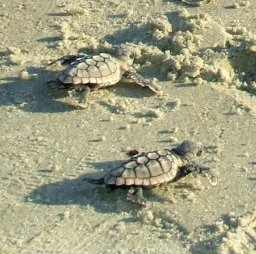
Turtle Watch Program – 2024
The first nest of the 2024 season was on May 18th
Average annual number of nests is 57
Current nest count – (29) as of 06/21/24
Members of the patrol started riding the beach every morning on May 1 and will do so through October looking for signs of turtle nests.
For more information » click here
5 things to know about sea turtle nesting season along the NC coast
On May 6, Oak Island had something to celebrate: the Oak Island Sea Turtle Protection Program took to Facebook to announce its first sea turtle nest of the season — also the first nest of the year in North Carolina.
In the coming months, many female sea turtles will follow, making their way onto local beaches to lay their eggs.
Here’s what you need to know about sea turtles.
When do sea turtles come ashore?
Sea turtle nesting season occurs each year from May through September. According to a fact sheet from the North Carolina Wildlife Resources Commission, female sea turtles emerge from the ocean at night, and using their flippers, dig an 18-inch-deep hole that will serve as the nest where she will deposit 80 to 120 eggs. After laying the eggs, she covers the nest and returns to sea.
What happens to the babies?
After about a 60-day incubation period, the hatchlings emerge and make their way to the ocean. Only about one in 1,000 hatchlings will live to reproduce.
Are there different kinds of sea turtles?
Yes. There are seven species of sea turtles worldwide, and five visit the beaches of N.C. According to information from the N.C. Wildlife Resources Commission, the most common in North Carolina is the loggerhead, but one may also see leatherback, green, hawksbill, and Kemp’s ridley.
How can I help sea turtles?
The N.C. Wildlife Resources Commission’s fact sheet lists the following tips:
- Use red filters on flashlights when talking on the beach at night.
- Do not disturb nesting sea turtles.
- Turn off outside lights facing the beach front during sea turtle nesting season.
- Keep dogs on a leash.
- Reduce beach traffic around sea turtle nests.
- Properly dispose of trash.
- Be mindful of sea turtles when boating or using watercraft.
- Volunteer with the Commission, the Karen Beasley Sea Turtle Hospital, or a beach clean-up crew.
- Join a conservation organization.
- Donate to the N.C. Nongame and Endangered Wildlife Fund.
Who do I contact if I see a sea turtle on the beach?
The N.C. Sea Turtle Project works with 20 different volunteer groups. Contact information for each is available at nc-wild.org/seaturtles/contacts, or call the statewide sea turtle hotline at 252-241-7367.
Read more » click here
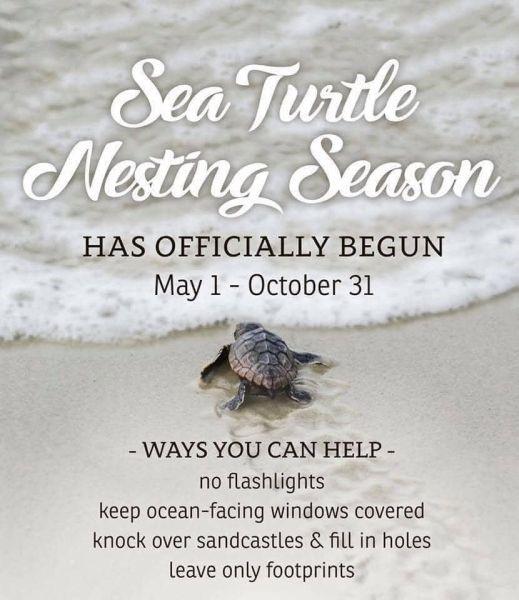
Upon Further Review –
‘It’s out of control’: OKI to explore limiting house sizes per council directive
The town council put forth a proposal to limit house sizes in Oak Island on Tuesday and the measure now heads to the town’s planning board for review. Council member Bill Ciullo proposed two scenarios in which the town could limit mega-home construction aimed at reducing an influx of rental houses instead of residences. Cuillo brought forth this idea at a meeting two weeks ago and the discussion was continued to Tuesday’s meeting. “Oak Island residents and homeowners have asked us to limit house size and maintain the small town feel of our community,” Ciullo said. “It was stated loud and clear in our comprehensive land use plan, as well as on election night.” Ciullo proposed two options; one would be to lower square footage on homes constructed to 3,500 square feet and eliminate residents’ ability to apply for special use permits to exceed that amount. The council member described this as a “simple, one-size-fits-all approach” that would apply to all single-family homes regardless of lot size. The second approach would be to limit home size as proportionate to lot size. The example put forth by Ciullo would limit homes on 6,600-square-foot lots to 2,970 square feet, while the allowance would cap at 4,000 square feet with no special-permit exception. Ciullo said the proportionate option would require town staff to examine their size-based zoning metrics for loopholes and complications — “crossing our Ts and dotting our Is,” he said. Council member Mark Martin said he was concerned about this approach, as the town already has land development rules based on lot size. The adopted rule would be applicable to all new construction across the island and in the R7 zoning district of the town’s mainland. The board member claimed that if the town did nothing, developers would continue to gobble up lots for 3,995-square-foot homes and incongruently build them next to smaller homes in the 1,000 to 2,000-square-foot range — this would be the first wave, he said. The second wave would be demonstrated by developers acquiring and demolishing those smaller beach bungalow properties to make way for their 15-bedroom complexes. “While many of the cows have left the barn, we still have plenty of cows left in the barn, which we can save,” Ciullo said. The council member requested the planning board be asked to review each option — and no alternative — to provide a recommendation to council; the motion was seconded by council member Terri Cartner. Council member Bill Craft said he and Ciullo were in harmony with their desire to eliminate special-use allowances for large homes, but he thought Ciullo’s warnings were overblown. He said every town he talked to, including Carolina Beach and Holden Beach, do not limit square footage and instead rely on impervious surface and setback regulations to limit development size. Craft said CAMA guidelines allow Oak Island beach houses to reach 5,000 feet, but noted very few would ever reach that size because the average lot size is 0.12 acres — homeowners would need two lots to reach an allowable 4,000-square-feet. The council member also addressed claims that Oak Island would become like Myrtle Beach, South Carolina, if action were not taken; that claim is common among coastal communities when faced with land development decisions. “That’s a scare tactic,” Craft said. He stated Oak Island maximum building height is 41 feet, while buildings in Myrtle Beach well exceed that. Craft suggested the town maintain its 3,995-square-feet limit and enforce it by eliminating special-use permits, as increasing the gap between the town’s allowance and CAMA guidelines would put the town at risk of a lawsuit. This is not the first time the issue of short-term rentals or house size has crossed the Oak Island dais. Both Craft and council member John Bach have voted to restrict house sizes in the past. “What both of you have illustrated is what people say to me — it’s out of control,” Bach said. “And I’m forced to say, ‘Yeah, but it’s legal.’” He said he supported the planning board’s exploration of Ciullo’s two options. Martin said he was wary of targeting full-time investment rental properties. “Why would I deter my neighbor’s ability to rent their home if they’re in financial need?” Martin said. Martin said he was in favor of special use permits as it allowed council to place conditions on the property they otherwise would not be able to; Ciullo disputed this, saying the permits have been used against them and improvements are made with commercial properties, not residential. Martin was also against the limitations put on the planning board, suggesting the body be allowed to explore and recommend business as usual and the 5,000-square-foot ceiling. Ciullo said free-ranging discussion could last until Christmas. “There’s expectations around people that own property; they see what’s being built, they see design, they understand what’s possible,” Martin said. “They’ve been sitting on these parcels, and now it’s time for them to make their dream come true.” Bach asked that council further debate the issue when the planning board submitted their determination, which could be that neither option was satisfactory, though alternative solutions are not being solicited. The vote to send the issue to the planning board passed 4-1, Martin dissenting. The planning board has until Aug. 26 to return a recommendation.
Read more » click here
Corrections & Amplifications –

Odds & Ends –
 Want to fish at the NC coast? Then you need a license.
Want to fish at the NC coast? Then you need a license.
Whether you’re a tourist or a local angler, you need a license to fish at the N.C. coast. Here’s why, and how to get one.
If you’re headed to the beach or plan on hitting the water this summer, there are some things you are certainly going to pack. Sunscreen to protect you from the scorching Carolina sun, more than likely a few beverages to keep you hydrated, and maybe some beach toys and a Shibumi Shade are all likely coming along. But if you plan on casting into the surf or testing your luck in the state’s offshore or inland coastal waters, there’s one more thing you need: a fishing license. Whether you are a tourist from Tennessee, an avid angler from Asheville, or a local lad from Leland, recreational fishermen of all skill levels over the age of 16 have been required to have a valid N.C. Coastal Recreational Fishing License since 2007. The idea isn’t to discourage fishing, but the exact opposite. “We want to help protect and maintain this natural resource that we all enjoy for our generation and for future generations,” said Capt. Garland Yopp with the N.C. Marine Patrol. Proceeds from license sales are used by the N.C. Division of Marine Fisheries (DMF) and state Wildlife Resources Commission (WRC), which manages North Carolina’s freshwater public waters and shares management of some inner coastal areas with DMF, to manage, protect and conserve the state’s marine resources − from making sure fishing stocks aren’t falling too low to maintaining and expanding public boat launch sites. And with fishing, like many other outdoor activities, exploding in popularity since the COVID-19 pandemic, coupled with the tremendous growth all of the N.C. coast has seen in recent decades, that’s becoming a bigger challenge every year, said Yopp, who oversees the state’s southern coastal areas.
Who needs a N.C. fishing license?
Basically, anyone over 16 who intends to fish. A coastal fishing license is required even if you’re just planning to do some catch-and-release fishing, not catching something for personal consumption. Yopp said that includes fishing offshore, since boaters will have to traverse state waters − which extend 3 miles offshore − when traveling to and from their offshore fishing grounds. Commercial piers, however, have a blanket license that covers recreational fishermen, so individuals don’t need their own license to fish from them. Folks also can fish license-free anywhere along the coast on July 4.
How do I get a license?
Government isn’t generally known as an entity that makes it easy to get the necessary permit or paperwork to do something. But that’s not the case when it comes to fishing licenses. Yopp said probably the easiest way to get a license is through the WRC’s online portal. Once you’ve selected and paid for your license, you will receive a digital copy of your license that you can keep on your cellphone or print out for a hard copy. Fishing licenses also can be purchased at most big box retailers, like Walmart, sporting good shops, some hardware stores, and at local DMF and WRC offices.
Are there different types of licenses?
Yes, so a tourist visiting Brunswick County for a week doesn’t have to buy a year-long license that a beach house owner from the Triangle might want. A short, 10-day coastal fishing license is $6 for a N.C. resident and $11 for a nonresident. Annual licenses are good for one calendar year from when they are issued. For state residents, a 1-year license costs $16. It is $32 for a nonresident. Since a separate fishing license is required to fish in the state’s freshwater lakes, rivers and streams, fishermen also have the option of buying a unified license. North Carolina also offers lifetime licenses and discounted licenses for certain groups, like disabled veterans. Information on the types of fishing licenses and their cost can be found at www.eregulations.com/northcarolina/fishing/fishing-licenses.
What if I cast without a license?
Yopp said officers have the option of issuing a verbal warning or charging someone with a misdemeanor, which carries a fine that can range from $35 on up and could see future fishing privileges suspended, depending on the situation. He said most fishermen understand and want to follow the rules, and many of the issues law enforcement comes across have to do with licenses that have expired. “We still do see some violations, because like anything you always have some bad apples,” Yopp said. “But as a general rule we have pretty good compliance.” He added that just because you are a weekend angler or a tourist doesn’t mean you aren’t responsible for knowing N.C.’s fishing rules, and that includes what you can catch and keep. “If you don’t know how to ID a fish or what size is legal, then you probably shouldn’t have it in your ice chest,” Yopp said, adding that there are plenty of online information on the DMF’s website and via smartphone apps like FishRules to help keep fishermen informed. “I really think most fishermen want to do the right thing, and most of them do.”
Read more » click here
This and That –

This Brunswick town has the best beach in NC, according to a USA TODAY poll
Southeastern North Carolina towns dominated a USA TODAY 10Best reader poll ranking the state’s best beaches. On Tuesday, USA TODAY announced the results for its Best Beach in North Carolina poll, as well as best beaches in six other states. Candidates for 10Best lists are chosen by expert panels and voted on by readers to determine the final top 10 for each list. Of the 10 beaches recognized on the Best Beach in North Carolina poll, area beaches occupied eight spots. Ocean Isle Beach was named the best beach in the state, with all three New Hanover County beaches following — Carolina Beach in second place, followed by Kure Beach and Wrightsville Beach. Oak Island and Holden Beach, both Brunswick County beaches alongside Ocean Isle, took the fifth and sixth rankings. Pender County’s Topsail Beach and Surf City were placed ninth and 10th.The only beaches recognized that were not located in the Wilmington area were Atlantic Beach and Kill Devil Hills.
Here’s the top 10:
- Ocean Isle Beach
- Carolina Beach
- Kure Beach
- Wrightsville Beach
- Oak Island
- Holden Beach
- Atlantic Beach
- Kill Devil Hills
- Topsail Beach
- Surf City
Read more » click here

Trends report: Wilmington first among most moved-to cities
What states and cities are becoming popular moving destinations? PODS Enterprises LLC, released its fourth annual Moving Trends Report identifying the top 20 cities Americans are fleeing from, and flocking to, in 2024. The report analyzes consumer movements throughout the past 15 months, identifying the environmental and economic factors that inspired these trends. Wilmington, for the second consecutive year, landed the top spot on the move-in list. The area was tied in with nearby Myrtle Beach, South Carolina. “Last year, we noted the Carolinas were worth watching, and this year, they’ve not only taken the trophy as the number one spot for new moves but also broken a record,” said Rich Schwartz, SVP of Corporate Operations at PODS. More Americans are calling the Southeast home with the promise of lower costs of living, an exceptional quality of life, the food scene, easy access to nature, and vibrant metro areas. Wilmington is well known for its 1.75-mile-long Riverwalk, seafood restaurants, markets, art galleries, narrated history tours and boat tours. Other attractions are the Battleship North Carolina and the Cotton Exchange, a shopping complex consisting of historical buildings dating back to the late 19th and early 20th centuries, located in downtown Wilmington.
The top 10 cities with the highest number of move-ins:
- Myrtle Beach, South Carolina / Wilmington (1stin 2023)
- Ocala, Florida (4thin 2023)
- Houston (5thin 2023)
- Greenville-Spartanburg, South Carolina (10thin 2023)
- Charlotte (16thin 2023)
- Raleigh (20thin 2023)
- Phoenix (18thin 2023)
- Knoxville (7thin 2023)
- Jacksonville, Florida (8thin 2023)
- Asheville (17thin 2023)
Read more » click here
 This Brunswick County place was named one of the cutest in NC
This Brunswick County place was named one of the cutest in NC
A Brunswick County city, which has already been named one of the state’s friendliest, has something else to brag about. Southport made the World Atlas list of seven cutest small towns in North Carolina to visit in 2024. World Atlas cited Southport as a filming location for several movies and TV shows. Cinema buffs can go on a golf cart tour which stops by filming locations of more than 40 productions, including “Dawson’s Creek” and “A Walk to Remember,” which shot scenes in Old Smithville Burying Ground in spring of 2001. “I Know What You Did Last Summer” was also set in Southport with some scenes at Southport Marina and Franklin Square Park. “Tourism is our greatest industry, and our city is as welcoming as a Hallmark movie where everyone is treated like family and friends,” Mayor Joseph P. Hatem said, describing the local community. “If you walk through our unique neighborhoods, you will always be greeted with a friendly hello.” The town also offer many waterfront dining options, such as Fishy Fishy Cafe and Provision Company, both offering stunning seaside views and deliciously fresh seafood. And if you’re adventurous, you can explore the plenty of nearby beaches, such as Oak Island and Caswell Beach, which features the Oak Island Lighthouse, a 153-foot-tall lighthouse built in 1958. The World Atlas describes Southport as being filled with historic homes that visitors can admire, some even offering lodging, such as Robert Ruark Inn, a quaint bed and breakfast in a Victorian-style.
The other cities are:
- Banner Elk, located in the Blue Ridge Mountains, offers a relaxing escape and connection with nature.
- New Bern is perched along the Neuse River and is the birthplace of Pepsi-Cola.
- Sylva is a scenic town at the base of the Smoky Mountains.
- Blowing Rock, nestled in the North Carolina mountains, makes for a romantic getaway, girls’ trip or family vacation.
- Saluda is a small historic mountain town surrounded by waterfalls.
- Edenton, a waterfront town, sits along the Albemarle Sound and boasts many historic buildings dating back to the 18th century.
Read more » click here
Factoid That May Interest Only Me –
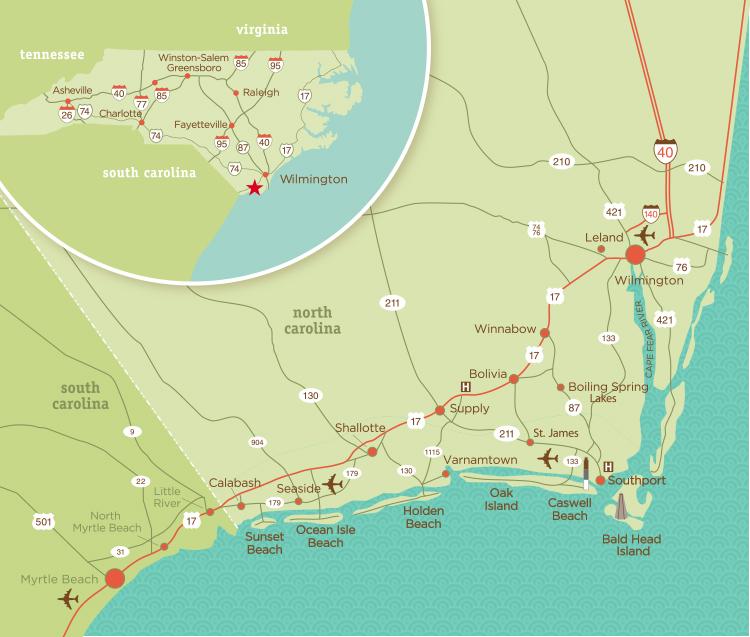 Living along the NC coast is increasingly risky.
Living along the NC coast is increasingly risky.
So why are property values still rising?
A new economic model suggests that tax incentives and federal subsidies help fuel coastal property price increases despite growing climate change risks, like sea-level rise
Anyone who has dreamed of owning a property at the beach knows that it’s a goal shared by many. Couple in the growing popularity of coastal living in general − the Wilmington-area’s population jumped from 200,000 in 1990 to more than 450,000 in 2020 − and home ownership is increasingly becoming the privilege of the rich and the few. According to a report by online research publisher Stacker using real estate data from Zillow, Wrightsville Beach has seen a nearly 74% increase in property values over the past five years, with the typical home value now pushing an eyewatering $1.46 million. That makes it the most expensive town in the state, with Bald Head Island a close second with a 76% increase in values in the past five years increasing the average home on the Brunswick County island to $1.3 million. Of the top ten priciest locales in North Carolina, six are coastal communities. But are government actions helping bake in the advantages that high-income property owners have in reaching the coastal dream even as evidence mounts that the risk from climate change and sea-level rise is making living along the ocean an increasingly risky proposition? That’s a question North Carolina researchers attempted to tackle in a recent study published in Nature Communications that looked at how economic incentives and subsidies are impacting coastal property markets. Dr. Dylan McNamara, professor of physics and physical oceanography at the University of North Carolina Wilmington and one of the study’s authors, said the changes occurring along much of the U.S. coast can’t be viewed as just uniquely physical or uniquely economic. “They are linked, a coupled human environmental system where the environment is impacting humans and humans are impacting the environment,” he said. Dr. Martin Smith, an environmental economics professor at Duke University, and McNamara created a new economic model called the Coastal Home Ownership Model (C-HOM) to analyze the long-term evolution of coastal real estate markets. Smith said government actions to protect and enhance coastal communities from environmental risks, such as sea-level rise and stronger and more frequent hurricanes, helps support and boost property values. “What it signals to the market is that this is a fine place to further invest,” he said. Paradoxically, as property values increase and coastal communities become more wealthy, it becomes easier for officials to justify additional and more expensive projects to maintain that economic value in these increasingly vulnerable areas. “We’re shielding these markets from the underlying risks they face, and hence propping up these markets,” McNamara said.
Subsidized sand
Take the history and role of beach nourishment projects, for example. When Congress decided to get the federal government involved in the beach-building business nearly six decades ago, the thinking was oceanfront communities would only require sand roughly once every 10 years or so. The cost of these federal projects would be split between Washington and local governments, with the federal government picking up most of the tab and the state and/or local communities paying the rest. As erosion has increased thanks to sea-level rise and more frequent storms, that’s now been reduced to every couple years − a timeline that doesn’t include federal emergency beach-building projects after major storms. And as more towns see their beaches washing away and confront the high costs of nourishment, thanks to sand scarcity and increased environmental regulations, there is a growing chorus of communities who want their own federal nourishment project. Currently, New Hanover County’s three beach towns and Ocean Isle Beach in Brunswick County are the only North Carolina communities that are guaranteed a periodic injection of fresh sand largely funded by the federal government. Critics say beach nourishment projects funded by federal taxpayers are bad long-term investments that literally just wash away, only benefit rich oceanfront property owners, and have to be repeated every few years to be truly effective. Backers claim beach-building projects are vital to keeping coastal economies running, protecting oceanfront properties and vital infrastructure, and helping communities hit hard by hurricanes rebound.
Analyzing the trade-offs
Both McNamara and Smith said there’s no doubt taxpayer-subsidized projects like beach nourishments have short-term and even medium-term economic benefits. But the cost of defending the shoreline, while propping up property values, is itself increasing. That means more of those costs need to be shouldered by state and local governments if they have the necessary political will and the deep pockets. McNamara and Smith also warn that those rising costs, which beach towns will increasingly have to pass on to their residents or private property owners will have to fund themselves, coupled with surging property values will likely increase the gentrification of many coastal communities − a process that’s already occurring in many beach towns. Some North Carolina coastal communities are already facing these tough decisions. In 2022, North Topsail Beach pulled out of a federal beach nourishment project with Surf City over cost concerns, and Dare County has told residents of Rodanthe, an unincorporated community on Hatteras Island that has some of the highest erosion rates along the entire N.C. coast, that it simply can’t afford to nourish the village’s eroding beach that has already swallowed several homes. Increasing home and flood insurance premiums also are heaping additional pressures on many coastal residents. With the impacts from climate change expected to get worse in the coming decades, the researchers said change is coming. How officials manage the long-term economic adjustments required to adapt to an evolving environment so that they don’t all hit at once could be key to sustaining some of these coastal communities. ”As markets begin to sniff out those impacts, which is to say as the risk begins to increase, values will begin to go down,” McNamara said. “So, the question is when do we see that trajectory, and what path will it take.” Potential options the researchers suggest include managed retreat, possibly including the idea of a purchase and buy-back program so owners can continue to “rent” their homes until they have to move, and building smaller, movable structures that can more readily react to the rising ocean levels instead of the McMansions that are increasingly proliferating along the coast. “There are certainly trade-offs,” Smith said, “but we want people to have a clear view of what those trade-offs are.”
Read more » click here
Beach Strand –

These counties have the most shark attacks on North Carolina’s coast.
With tourists flocking to North Carolina beaches for the start of the summer, people will be diving into the home of many ocean creatures and that includes one of the most dangerous — sharks. The Florida Museum has an International Shark File as Florida is the top state for shark attacks in the United States. The file logs shark attacks all across the world and includes top attack states in the country, one of those states being North Carolina, which came in at No. 5.
Types of attacks
The International Shark File uses a number of different categorizations to describe attacks, including unprovoked bites, provoked bites, boat bites, scavenge, public aquaria, no assignment could be made and not confirmed.
Here are the worldwide statistics for shark attacks in 2023.
- Unprovoked bites: 69
- Provoked bites: 22
- Boat bites: 9
- Scavenge: 2 (post-mortem bites)
- Public Aquaria: 1
- No assignment could be made: 1
- Not confirmed: 16
How does North Carolina rank?
Out of all the states in the country, North Carolina ranks No. 5 for shark attacks behind its sister state South Carolina. North Carolina has had 80 confirmed unprovoked shark attacks since 1837. South Carolina has had 118, California has had 138, Hawaii has had 195 and Florida came in first at a whopping 928 unprovoked attacks.
County breakdown
Two of the Cape Fear region’s counties lead the numbers for confirmed unprovoked shark attacks since 1935 in North Carolina. Brunswick County tops the list with 18 attacks, followed by New Hanover County with 15 attacks.
Here’s the full list:
- Brunswick County: 18
- New Hanover County: 15
- Carteret County: 14
- Dare County: 11
- Onslow County: 10
- Hyde County: 4
- Currituck County: 3
- Pender County: 2
From 2012-2021, there have been a total of 31 bites in the state, but none of them have been fatal, according to the International Shark File.
What are the odds?
According to the Florida Museum, more people in the water has a strong correlation to the amount of attacks, which could point to why Brunswick County is at the top of the list for attacks on North Carolina’s coast as it is the fastest-growing county in the state. New Hanover County and Brunswick County are also part of the Wilmington Metro Area, which ranked No. 9 in the U.S. Census Bureau’s Top 10 U.S. Metro Areas from July 1, 2022, to July 1, 2023. But, although the chances are not zero, a person has a far greater chance of drowning than they do death by shark attack, according to the Florida Museum.
How to reduce the risk
Here are some tips provided by the Florida Museum to help keep yourself and others safe in the water this summer.
- Swim with a buddy.
- Stay close to shore.
- Don’t swim at dawn or dusk.
- Don’t swim around schools of fish or where people are fishing.
- Avoid wearing jewelry.
- Avoid excess splashing.
What to do when a shark is near
- Maintain eye contact with the shark.
- Slowly move away, and if possible, exit the water.
If the shark tries to bite you
- Hit shark in the eyes and gills —
Sensitive areas that can be hurt regardless of personal strength. - Hit the shark on the snout and push away —
Water-resistance weakens your punch.
- Hit shark in the eyes and gills —
Read more » click here
As weather warms, nesting shorebirds and sea turtles join people heading to NC’s beaches
With people flocking to the coast, officials hope education and outreach can help efforts to share the sand with nesting birds and sea turtles.
As the weather warms, sun-seeking tourists aren’t the only ones drawn to North Carolina’s rich necklace of barrier islands along its 320 miles of coastline. If you’re visiting the beach this summer, there’s a good chance you’ll see wildlife mixed in with visitors and the occasional resident. But sharing valuable beach real estate with nesting shorebirds and sea turtles can be challenging. Mix in the loss of habitat on many islands to development, the growing risk from climate change, and the increased threat of disturbance tied to human activities, dogs and even predators and the odds are often stacked against the native fauna. The eggs and chicks of nesting shorebirds often blend in perfectly with the sand, making it easy for people or pets to accidentally step on them. Getting close to the nests or babies can be just as bad, scaring the parents off and leaving the eggs and chicks at the mercy of predators and the summer heat. That’s where groups like the N.C. Wildlife Resources Commission and Audubon North Carolina come in to help level the playing field. Hundreds of signs ring the state’s coastal nesting sanctuaries from Currituck Sound in the north to Sunset Beach in the south, warning visitors to respect nesting areas. In some locations, including Wrightsville Beach, volunteers help reinforce that message. Hope Sutton, eastern wildlife diversity supervisor with the wildlife commission, said education and outreach efforts are some of the most powerful tools officials have to raise awareness about the birds’ requirements. “It’s a critical component, whether its students at Wrightsville Beach Elementary making cute signs to warn beachgoers to stay out of the refuge or adults learning about these birds through one of our outreach activities,” she said. “Our behavior patterns can really impact the chance of success many of these birds species have.” The helping hand comes as regulators worry about the future of some of the state’s shorebirds. North Carolina’s 2023 waterbird survey, which is conducted every three years and is a collaborative effort among government agencies and environmental groups, showed substantial dips in the numbers of many nesting shorebirds. Among wading birds, that list included cattle egrets, tricolored heron, little blue herons, snowy egrets and glossy ibis. Beach-nesting species showing substantial declines included the common tern, gull-billed tern, and Caspian tern. Another species that is in trouble is the black skimmer, with North Carolina’s population decreasing by half since 1999. Because skimmers nest directly on the open sand, they are especially vulnerable to disturbance and loss of nesting sites. But the survey wasn’t all bad news. Least tern numbers were found to be increasing, with many of the nests found on the beaches at the south end of Wrightsville Beach and on Lea-Hutaff Island in Pender County. Brown pelicans also are doing well, with 5,227 nests reported in 2023, well above the 15-year average of about 4,000 nests. Many of the shorebirds holding their own nest on spoil islands, like those in the Cape Fear River or Intracoastal Waterway, or on sections of protected natural areas like Masonboro Island that are hard to access. But climate change is an unknown variable that could add to the pressure many species face. On low-lying manmade dredge islands, for example, rising seas and stronger tropical storms tied to warming temperatures could increase erosion and over wash threats. “And the competition for sand is already tough and is likely to get worse in the coming decades,” Sutton said, referring to the limited nearshore sand resources and many coastal towns now seeking nourishment projects to boost their eroding beaches. A warming climate also could prompt some birds to nest sooner. Lindsay Addison, a coastal biologist with Audubon North Carolina, said learning to share the beach and knowing when to back away, such as when a shorebird starts acting irritated, can go a long way to help. “Anyone who has lived down here for a while knows that there are more and more people now, and sometimes it’s really hard to go anywhere along the coast and not run into a lot of people,” she said. “The birds also are experiencing that, and there are a lot of opportunities for people to disturb them and impact their survival. “But if we just keep our distance and take some other steps, like keeping our dogs on a leash during certain times, it can make a really huge difference.” Shorebird nesting season runs from March through mid-September.
Turtle time
Shorebirds aren’t the only ones looking to nest on area beaches. Peak sea turtle nesting season begins May 1 and continues through the end of October. Most local beaches are monitored daily during sea turtle nesting season to look for evidence of nests, which are then monitored and protected if needed during the roughly two-month incubation period. While sea turtle nesting numbers have been showing increases in recent years, regulators and environmentalists warn the marine reptiles still face many threats − especially during the decades they navigate the oceans before females return to their birth beach to nest. While on the beach, threats dangers include holes dug in the sand and left by beachgoers, which can trap hatchlings after they emerge from the nest, and bright lights from homes and businesses that can distract nesting mothers and hatchlings and lead them away from the ocean.
Sharing the beach
Tips from the N.C. Wildlife Resources Commission on how to share the beach with nesting wildlife this summer:
- Respect the boundaries of the roped-off nesting areas
- Keep dogs on a leash
- Follow beach driving regulations
- Throw away trash properly, including fishing line and kite strings
- Don’t feed sea gulls or least terns
- Don’t fly drones or kites near nesting sites
Read more » click here
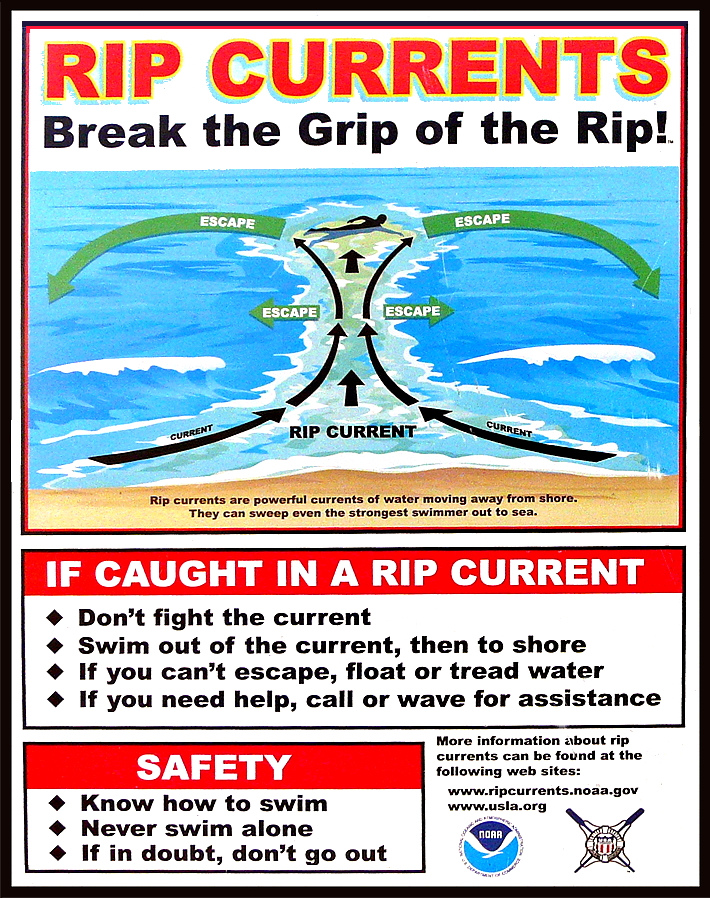
Most rip current deaths are preventable. Yet people keep drowning.
Beach-safety experts are frustrated by the mounting fatalities despite awareness campaigns and improved forecasts
Rip-current deaths in the United States are running ahead of last year’s pace — at least 29 since the beginning of the year — with peak beach season yet to come. Experts are warning the public to be aware of this largely hidden hazard ahead of Memorial Day weekend, traditionally one of the busiest beach weekends of the year. The risk of dangerous rip currents is expected to be particularly high this weekend along portions of the Southeast coast where a storm could produce heavy rain, gusty winds and rough seas. Experts say most rip-current fatalities can be prevented. Still, the number of annual rip-current deaths has steadily climbed since the National Weather Service began tracking them in 2010, reaching a record of 130 in 2021, then dipping to 85 last year. Rip currents were the third-leading cause of weather-related deaths from 2012 to 2021, behind only heat and flooding, according to the Weather Service, and in a typical year they kill more people than lightning, hurricanes or tornadoes. Rip currents are strong, narrow streams of water that flow away from the shoreline and can suddenly sweep swimmers out to sea. They can form on almost any beach with breaking waves, especially near low spots or breaks in sandbars, and near jetties or piers. Predicting where and when a rip current will form is difficult because of the many weather and ocean factors involved. The Weather Service cautions that “rip currents often form on calm, sunny days.” The Weather Service lists 26 rip-current deaths this year through April 27, not including three deaths believed to be caused by rip currents on April 28 in Destin, Fla., May 6 in Ocean City, Md., and May 12 at Cannon Beach, Ore. At this point last year, there were 19 total such deaths. Beach-safety experts are expressing frustration as fatalities trend higher again this year despite annual awareness campaigns, such as the United States Lifesaving Association’s National Beach Safety Week held every year during the week before Memorial Day, and recent improvements to rip current forecasts. “It is frustrating when we produce videos and graphics and educational information and release it at the beginning of each beach season, and it still misses so many people,” Scott Stripling, a senior meteorologist at the National Hurricane Center in Miami, said in an email. “The problem seems to be one of communication and/or lack of attention by the general public.”
Rip-current forecasts and warning signs
The Weather Service issues daily rip-current forecasts for beaches on the Atlantic Ocean, Gulf Coast, Southern California, Great Lakes, Puerto Rico and the U.S. Virgin Islands. The forecasts categorize the rip-current risk as low, moderate or high, and are informed by a rip-current model recently developed by NOAA that has made it possible to differentiate the risk between adjacent beaches. Previously the same forecast could span 100 miles or more. However, the model doesn’t enable reliable forecasts of the exact location and time of rip currents. These are influenced by a number of factors including wave characteristics, water levels, winds and the shape of a beach. Advances in artificial intelligence could help with rip-current detection — NOAA is partnering with the Southeast Coastal Ocean Observing Regional Association on a project using AI to detect rip currents in webcam imagery — but such efforts are still in their infancy. In some cases, there are visible clues to the existence of a rip current, such as a break in the waves, foamy water or objects being carried offshore, or darker water that is due to a break in a sandbar. Often, though, rip currents are difficult to see, or are best seen from a high point such as a dune line or the top of a beach access. Rip currents are particularly hard to spot in South Florida, where, the Weather Service says, they “consistently rank at or near the top of the list of deadliest weather-related hazards,” because there is not much sediment to darken or muddy the current at the shoreline. In Brevard County alone, home to nearly 72 miles of sandy beaches, there have been eight apparent rip-current drownings since November, all at beaches without lifeguards. “We have clear-water rips, so these offshore-flowing currents are very hard to detect,” Stephen Leatherman, a professor in the department of earth and environment at Florida International University, said in an email. “The best thing is to have lifeguards and for people to swim close to lifeguards. But lifeguards are very expensive, and Florida has 825 miles of good quality sandy beaches which are swimmable for most of the year.”
Warnings and tips for surviving a rip current
Rip currents flow at speeds up to 5 miles per hour. That may not sound fast, but it’s faster than many Olympic swimmers. If you are caught in a rip current, experts say not to swim directly back to shore against the current, which can quickly exhaust and drown you. Instead, swim parallel to the shore until you are out of the current, which is typically no wider than about 50 to 100 feet. You might also escape by floating or treading water, allowing the current to take you out just past the breaking waves where many rip currents tend to dissipate, and then circulate you back toward the shore. However, some rip currents can extend hundreds of yards offshore. If you see someone caught in a rip current, experts urge you not to risk your own life to attempt a swimming rescue unless you have been trained to do so and have a flotation device to assist you and the person in distress. Instead, you should get help from a lifeguard or call 911 if no lifeguard is present. You should also throw the victim something that floats, such as a lifejacket, body board, cooler or a ball, and yell instructions on how to escape. Experts agree that the best way to survive a rip current is to avoid it in the first place. That means checking the rip-current forecast before you enter the water, heeding warnings for rip currents or rough surf, and only swimming close to a lifeguard. The United States Lifesaving Association estimates the chance of someone’s drowning at a beach with a lifeguard at 1 in 18 million. “Lifeguards are trained to spot rip currents and other beach hazards and intervene as and when needed,” Chris Houser, a professor at the University of Windsor School of Environment and a longtime beach-safety researcher, said in an email. “While there is some evidence that individual beach users can be trained to spot rips, most beach users are not aware of what to look for.” U.S. lifeguards make an estimated 80,000 or more rip-current rescues each year, which suggests that education and warning messages are not reaching or are not resonating with as many people as experts would like. “If the lifeguards are flying precautionary flags, and there are signs on the lifeguard stand identifying the potential for rips in that area, and the National Weather Service and media have advertised that there is at least a moderate risk for rip currents to be present at your local beach, what else can we do?” the Weather Service’s Stripling said.
Read more » click here

 Staying safe at the beach: Rip currents, jellyfish, sharks, and other hazards
Staying safe at the beach: Rip currents, jellyfish, sharks, and other hazards
A trip to the beach can turn deadly (or painful) due to natural hazards but being aware of risks and mitigating hazards is a good way to prevent problems.
Picture this: warm weather, blue skies, and your toes in the sand — it sounds like a perfect lazy summer day at the beach. Maybe you decide to cool down in the ocean and find yourself bobbing around when suddenly you realize you are a little too far out. As panic sinks in and you start to swim towards dry land you realize your efforts are in vain and your whole body is getting tired, all the while you are drifting further into the Atlantic — you have gotten stuck in a rip current. It’s not the only potential danger in the ocean, though. There are also sharks. And, of course, there are some things on shore that ruin your day at the beach, too, including stepping on jellyfish and, of course, good old-fashioned sunburn.
Rip currents
According to the U.S. Lifesaving Association (USLA), 80 percent of all ocean rescues are related to rip currents and annually more than 100 fatalities across the country are due to rip currents. While it is obvious that swimming at a beach with lifeguards is one of the safer options, there are plenty of area beaches that lack lifeguards or maybe ocean rescue season has not started just yet. So, what is the best course of action for surviving a rip current? According to the National Weather Service, there are several things swimmers should keep in mind when dealing with these often-unseen dangers.
- Relax. Rip currents don’t pull you under.
- A rip current is a natural treadmill that travels an average speed of 1-2 feet per second but has been measured as fast as 8 feet per second — faster than an Olympic swimmer. Trying to swim against a rip current will only use up your energy; energy you need to survive and escape the rip current.
- Do NOT try to swim directly into to shore. Swim along the shoreline until you escape the current’s pull. When free from the pull of the current, swim at an angle away from the current toward shore.
- If you feel you can’t reach shore, relax, face the shore, and call or wave for help. Remember: If in doubt, don’t go out!
- If at all possible, only swim at beaches with lifeguards.
- If you choose to swim on beaches without a lifeguard, never swim alone. Take a friend and have that person take a cell phone so he or she can call 911 for help.
Sharks
Sharks are a fear on most every swimmer’s mind, regardless of the actual dangers posed by the large predatory fish. “NOAA states that while shark attacks are rare, they are most likely to occur near shore, typically inshore of a sandbar or between sandbars where sharks can be trapped by low tide, and near steep drop-offs where sharks’ prey gather. While the risks are small, it’s important to be aware of how to avoid an attack,” according to previous reporting.
Suggestions from NOAA for reducing the risk of a shark attack include:
- Don’t swim too far from shore.
- Stay in groups – sharks are more likely to attack a solitary individual.
- Avoid being in the water during darkness or twilight when sharks are most active.
- Don’t go in the water if bleeding from a wound – sharks have a very acute sense of smell.
- Leave the shiny jewelry at home – the reflected light resembles fish scales.
- Avoid brightly-colored swimwear – sharks see contrast particularly well.
Sunburns
Most everyone has experienced a sunburn at one point in their life and while not often thought as a major concern for many, overexposure to UV light can cause serious long-term problems including skin cancer. The Centers for Disease Control and Prevention (CDC) recommends using at least S.P.F. 15 sunscreen at least 15 minutes prior to sun exposure. Wearing a hat, long sleeves, and other protective clothing is also recommended to keep skin protected.
Jellyfish
Jellyfish and Portuguese Man of War have been spotted along the beaches of New Hanover County and surrounding area beaches already this season and the little floating creatures can pack a punch. Often times beachgoers will spot them washed up on shore and other times they can be spotted in the water, but it is best to avoid them when you can. “While all jellyfish sting, not all contain poison that hurts humans. Be careful of jellies that wash up on shore, as some can still sting if tentacles are wet. NOAA recommends that if you are stung by a jellyfish to first seek a lifeguard to give first aid. If no lifeguards are present, wash the wound with vinegar or rubbing alcohol,” NOAA suggests. And what about that … other method of treating stings? Turns out, it’s a myth. In fact, urine can actually aggravate the stinging cells of jellyfish, making things worse. These cells, which detach and stick into the skin of prey, can continue to inject venom. Urine, as well as fresh water, can cause an imbalance to the salt solution surrounding the stinging cells, causing them to continue to fire. According to Scientific American, if you don’t have vinegar or rubbing alcohol, rinsing with salt water may be your best bet.
Read more » click here

Hot Button Issues –
Subjects that are important to people and about which they have strong opinions

Climate
For more information » click here.
A streak of record global heat nears one-year mark
April marked an 11th consecutive month of record global heat, the latest sign that humans are in uncharted climate territory. But there is reason to predict planetary temperatures could moderate soon, though they would remain far above old normals because of human-caused global warming. “If 2024 continues to follow its expected trajectory, global temperatures will fall out of record territory in the next month or two,” Zeke Hausfather, a climate scientist with the payments company Stripe, wrote in a newsletter. For now, the spate of unprecedented global heat continues to be felt around the world. April began with a heat wave across West Africa that was so intense, an analysis determined it would have been “virtually impossible” without the influence of human-caused planetary warming. The month ended with a stretch of record-setting heat across Southeast Asia, with temperatures surging well above 100 degrees and up to 120 degrees in some areas from India to the Philippines. But data suggests a diminishing trend in the margins by which average global temperatures are setting records. Hausfather called it “gobsmackingly bananas” when September set a new monthly average global temperature record by an unprecedented margin of 0.5 degrees Celsius. October set a record by a margin that was nearly as large and marked what was then the hottest 12-month period ever observed. Preliminary data shows last month was 0.1 to 0.2 degrees Celsius warmer than the next-hottest April, a significant margin but relatively closer to past observations. Climate scientists said it could be a sign that the surge of global warmth over the past year is beginning to wane, if only slightly. That is because of the imminent end of a historically strong episode of the planet-warming climate pattern El Niño, which began nearly a year ago. During El Niño, warm waters pool along the equator in the eastern and central Pacific Ocean, releasing heat into the atmosphere and triggering extreme heat waves, droughts and floods around the world. Climate models suggest that a rapid switch to the relative cooling influence of La Niña appears increasingly likely this summer or fall. During La Niña, cooler-than-average surface temperatures dominate the eastern and central equatorial Pacific. That could mean this year approaches but does not quite match the record average global heat observed on an annual basis in 2023, scientists said. Berkeley Earth climate scientist Robert Rohde recently predicted 2024 would end as the warmest or second-warmest year on record. Hausfather said that while the year has so far averaged about 1.7 degrees Celsius above preindustrial levels, before the influence of humans’ fossil fuel consumption began, it is likely to end about 1.5 degrees above that benchmark. How rapidly global temperatures moderate, if at all, will be key in gauging whether climate change is accelerating, NASA climate scientist Gavin Schmidt wrote in a Nature column in March. If La Niña develops and the record warmth does not moderate, it could signal that humans have “fundamentally altered” Earth’s climate system, he said.
Read more » click here
North Carolina map shows where state could be underwater from sea level rise
An interactive map shows how parts of North Carolina could be submerged in water as sea levels rise due to the effects of climate change.
The state faces particular risks because of its barrier islands, known as the Outer Banks, its extensive coastline and its low elevation. An interactive map shows how parts of North Carolina could be submerged in water as sea levels rise due to the effects of climate change. The state faces particular risks because of its barrier islands, known as the Outer Banks, its extensive coastline and its low elevation. The United Nations’ Intergovernmental Panel on Climate Change (IPCC) projects that by the year 2100, global sea levels will have risen by between 0.95 and 3.61 feet. However, it notes that a rise of around 6.6 feet “cannot be ruled out.” If sea levels rose by just 3 feet, parts of North Carolina’s barrier islands and coastal areas would be encroached by water, according to projections by the NOAA. If sea levels were to rise to 6 feet, nearly the entire counties of Dare, Hyde and Tyrrell would be submerged. If sea levels were to rise to that level, parts of Wilmington, one the state’s largest cities which is known for its historic downtown riverwalk, would also be affected, according to the map. Some coastal parts of North Carolina are already preparing for rising sea levels. The Outer Banks town of Nags Head has said it is factoring the issue into its zoning code, stormwater and flood and dune protection. The state has also widened its beaches by pumping sand from the ocean onto its shorelines. The rates by which sea levels might rise are at this point imprecise projections and could vary depending on what actions countries take to tackle climate change and slow the melting of ice caps. David Thornalley, a professor of ocean and climate science at University College London, previously noted that 2100 was only one lifespan away, and that significant sea rises “would happen if we didn’t take steps to reduce our GHG (greenhouse gas) emissions.” NOAA oceanographer William Sweet said in a previous email to Newsweek: “NOAA’s Sea Level Rise Viewer is a versatile mapping platform that provides insights on what lies in harm’s way—either from ongoing sea level rise or flooding from full-moon tides to hurricane storm surges. “Due to decades of sea level rise, high tides are drowning wetlands and routinely flooding U.S. coastal communities, disrupting commutes and commerce and requiring extensive upgrades to public works like storm and waste-water systems.”
Read more » click here
A year of record global heat has pushed Earth closer to dangerous threshold
Temperatures surpassed the 1.5-degree Celsius warming threshold over the past year, and scientists warn they will again soon.
A streak of record-setting heat that began last summer has now persisted for an entire year across the globe, researchers announced Wednesday, pushing Earth closer to a dangerous threshold that the world’s nations have pledged not to cross. The data released by European climate scientists showed May was the 12th consecutive month during which average global temperatures surpassed all observations since 1850, and probably any extended period for more than 100,000 years. Over the past year, according to the European Union’s Copernicus Climate Change Service, global temperatures averaged 1.6 degrees Celsius (2.9 degrees Fahrenheit) above preindustrial levels. Under the landmark 2015 Paris agreement, the world’s leaders pledged to hold Earth’s temperature rise “to well below” 2 degrees C (3.6 degrees F) above pre-industrial levels and pursue efforts “to limit the temperature increase” to 1.5 degrees C above pre-industrial levels, to avert some of the worst effects of global warming. The fact that the planet surpassed 1.5 degrees C for one year does not amount to a permanent shift, but it comes as scientists are warning that it is likely to happen again — within a few years. The World Meteorological Organization said that it is highly likely that, for at least one calendar year in the next five, temperatures will exceed 1.5 degrees C above preindustrial levels once more. This unprecedented stretch of warmth, which has astonished scientists, prompted an urgent call by the United Nations to ban fossil fuel companies from advertising and encourage the public to stop using their products. “For the past year, every turn of the calendar has turned up the heat,” U.N. Secretary General António Guterres said in a special address in New York. “Our planet is trying to tell us something. But we don’t seem to be listening.” Researchers have linked the rise in temperatures to the El Niño climate pattern and decades of global heating from human emissions of greenhouse gases. A decade ago, scientists had estimated that the chances of the planet warming 1.5 degrees C by 2020 were nearly zero. Now, the probability of that happening by 2028 is an estimated 8 in 10.
A year-long surge of record heat
Global temperature records have been broken by significant margins since last June, as a burgeoning El Niño began releasing vast stores of heat from the Pacific Ocean. During the periodic climate pattern, warmer-than-average waters pool along the equator in the central and eastern Pacific, transferring warmth and moisture into the atmosphere and triggering extreme heat waves, floods and droughts around the world. In July, temperatures rose above the 1.5-degree C warming benchmark for an entire month, the first time that had happened. That warming trend then continued largely unabated. Global surface-air temperatures last month averaged 1.5 degrees C higher than the 1850-1900 global average, according to Copernicus. Carlo Buontempo, the Copernicus director, said that as remarkable as the trend is, “this string of hottest months will be remembered as comparatively cold” without action to reverse it. Emissions of carbon dioxide and other greenhouse gases from burning fossil fuels such as coal, oil and gas act to trap heat within the atmosphere, preventing it from escaping into space. A separate study published by a group of 57 scientists on Wednesday found that human activities were responsible for 92 percent of the warming observed in 2023, the planet’s hottest calendar year on record. It said the rate of warming in the past decade is “unprecedented in the instrumental record.” Data on global temperature records come from direct observations from ground sensors dating back nearly two centuries, satellite observations in more recent decades, and evidence from historical records and geologic analyses that go further back in time. While this data may not allow scientists to determine how hot it was on a single day or over a period of months many thousands of years ago, it does give confidence that the planet has not experienced such rapid and sustained warming since the end of the last ice age about 125,000 years ago.
Accelerating predictions of global warming
As warming has surged, projections of Earth’s temperature trajectory have accelerated. The latest version of a periodic report on near-term warming, also released Wednesday, shows it has become nearly a certainty that global temperatures will continue to cross into dangerous territory. At a sustained average of 1.5 degrees C above preindustrial levels, the U.N. Intergovernmental Panel on Climate Change has warned that weather will become so extreme, many people will struggle to adapt to it. “The difference between 1.5 and 2 degrees could be the difference between extinction and survival for some small island states and coastal communities,” Guterres said. Many climate scientists say that the Paris agreement’s target of no more than 1.5 C is already out of reach, though they stress that a single year above that level of warming does not mean the goal is lost. Scientists now estimate an 86 percent chance that at least one of the next five years also surpasses the record average annual temperature observed across the globe in 2023.
An increasingly dire call to action
Guterres used the data to stress the urgency of climate action ahead of a June meeting in Italy of the Group of Seven — the world’s wealthiest democracies — where matters of war and global trade are expected to take center stage. He repeated past calls for countries to stop investing in new coal power generation, and for developed countries to increase investment in clean energy and extreme weather adaptation, especially in poorer countries that have done the least to contribute to climate change and are feeling some of its worst effects. And Guterres is now demanding that all countries ban advertising from fossil fuel companies and that media and tech companies stop taking those companies’ ad dollars. Several cities and one country have already banned some fossil fuel advertising. Last month, the city council of Edinburgh, Scotland, voted to ban advertisements for fossil fuels as well as ads for SUVs and aviation. Amsterdam similarly has prohibited advertisements of gas-powered cars and airplane trips in the city’s center and subway stations. And after French President Emmanuel Macron asked 150 ordinary citizens to help with climate policymaking, his nation banned advertisements for coal, petroleum and hydrogen made from fossil fuels in 2022, though fossil fuel companies can still sponsor events. “We are playing Russian roulette with our planet,” Guterres said. “We need an exit ramp off the highway to climate hell.”
Read more » click here
There’s something happening here
What it is ain’t exactly clear
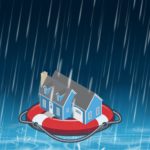
Flood Insurance Program
For more information » click here

National Flood Insurance Program: Reauthorization
Congress must periodically renew the NFIP’s statutory authority to operate. On March 22, 2024, the president signed legislation passed by Congress that extends the National Flood Insurance Program’s (NFIP’s) authorization to September 30, 2024.
Congress must now reauthorize the NFIP
by no later than 11:59 pm on September 30, 2024.

GenX
For more information » click here

Homeowners Insurance
For more information » click here
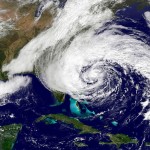
Hurricane Season
For more information » click here
The 2024 hurricane season could be busy.
Here’s what to expect in North Carolina.
“This is the highest prediction for hurricanes that (Colorado State University) has ever issued with their April outlook.”
The start of the 2024 hurricane season is sneaking up just as the weather warms, and forecasters are already out with their early-season predictions. But with climate change warming the oceans and air temperatures seemingly hitting new highs every month, with the European Union’s climate service declaring March to be the 10th consecutive month of record worldwide temperatures, is it only a question of how bad things will be this year? Or will Southeastern North Carolina be able to (mostly) dodge the proverbial storm bullet for another year?
What are forecasters saying?
According to forecasters at Colorado State University (CSU), who have been releasing April predictions since 1995, the 2024 season will be “an extremely active Atlantic hurricane season.” The researchers are predicting 23 named storms, with 11 becoming hurricanes and five of those becoming Category 3 or stronger systems. That’s about 170% of the usual storm activity of an average year. “This is the highest prediction for hurricanes that CSU has ever issued with their April outlook,” stated the researchers in a release.
The probability of one of those storms making landfall on the mainland U.S.:
- 62% for the entire U.S. coastline (average from 1880–2020 is 43%).
- 34% for the U.S. East Coast, including the Florida peninsula (average from 1880–2020 is 21%).
- 56% probability a hurricane will come within 50 miles of the N.C. coast, 85% for a named tropical storm.
The researchers added that the predicted storm activity is exhibiting characteristics similar to the 2010 and 2020 seasons.
How bad were 2010 and 2020?
For the Wilmington area, the 2010 hurricane season didn’t bring too many impacts − although Tropical Storm Nicole did drop more than 22 inches of rain on the Port City, flooding more than 100 roads in Brunswick County and leaving chunks of Pleasure Island underwater. But for the Atlantic basin as a whole, it was very busy, with some of the more brutal storms, particularly Alex and Karl, hammering the Caribbean and Mexico’s Yucatan Peninsula. A pair of Category 4 monsters, Danielle and Earl, also luckily stayed out mostly at sea. A decade later, 2020 proved to be the most active hurricane season ever with 30 named storms, 14 of which developed into hurricanes. That list included a record 12 U.S. landfalling storms, including Hurricane Isaias, which raked the Brunswick County beaches and knocked out power to nearly 400,000 customers in the Carolinas.
What about El Niño & La Niña in 2024?
While El Niño conditions have dominated for the past year or so, that should transition into La Niña by the time hurricane season rolls around. Dr. Michael Mann, a meteorologist and scientist at the University of Pennsylvania, said that will mean decreased wind shear in the tropical Atlantic and a more favorable environment for tropical cyclones.
Did we learn anything from the 2023 season?
Unfortunately, Mann said one of the lessons that last season reinforced was that in a world buffeted by climate change forecasters continue to have a tendency to under predict the actual number of named storms. He added that while ocean surface temperatures are somewhat retreating from the record heat we’ve seen recently, his team is still expecting to see abnormally warm water temperatures in the main development region of the Atlantic for storms. In other words, it could be a long, stormy season − so buckle up and be prepared. “It takes only one storm near you to make this an active season for you,” said CSU meteorologist Dr. Michael Bell. Hurricane season starts June 1 and runs through November.
Read more » click here
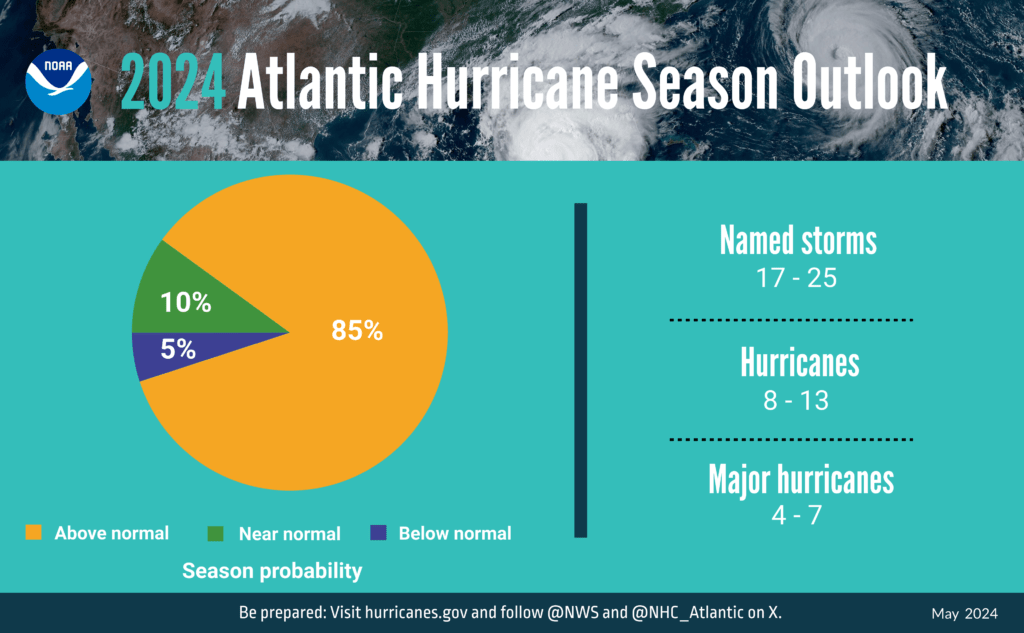 NOAA predicts above-normal 2024 Atlantic hurricane season
NOAA predicts above-normal 2024 Atlantic hurricane season
La Nina and warmer-than-average ocean temperatures are major drivers of tropical activity
NOAA National Weather Service forecasters at the Climate Prediction Center predict above-normal hurricane activity in the Atlantic basin this year. NOAA’s outlook for the 2024 Atlantic hurricane season, which spans from June 1 to November 30, predicts an 85% chance of an above-normal season, a 10% chance of a near-normal season and a 5% chance of a below-normal season. NOAA is forecasting a range of 17 to 25 total named storms (winds of 39 mph or higher). Of those, 8 to 13 are forecast to become hurricanes (winds of 74 mph or higher), including 4 to 7 major hurricanes (category 3, 4 or 5; with winds of 111 mph or higher). Forecasters have a 70% confidence in these ranges. The upcoming Atlantic hurricane season is expected to have above-normal activity due to a confluence of factors, including near-record warm ocean temperatures in the Atlantic Ocean, development of La Nina conditions in the Pacific, reduced Atlantic trade winds and less wind shear, all of which tend to favor tropical storm formation. “With another active hurricane season approaching, NOAA’s commitment to keeping every American informed with life-saving information is unwavering,” said NOAA Administrator Rick Spinrad, Ph.D. “AI-enabled language translations and a new depiction of inland wind threats in the forecast cone are just two examples of the proactive steps our agency is taking to meet our mission of saving lives and protecting property.” “Severe weather and emergencies can happen at any moment, which is why individuals and communities need to be prepared today,” said FEMA Deputy Administrator Erik A. Hooks. “Already, we are seeing storms move across the country that can bring additional hazards like tornadoes, flooding and hail. Taking a proactive approach to our increasingly challenging climate landscape today can make a difference in how people can recover tomorrow.” As one of the strongest El Ninos ever observed nears its end, NOAA scientists predict a quick transition to La Nina conditions, which are conducive to Atlantic hurricane activity because La Nina tends to lessen wind shear in the tropics. At the same time, abundant oceanic heat content in the tropical Atlantic Ocean and Caribbean Sea creates more energy to fuel storm development. This hurricane season also features the potential for an above-normal west African monsoon, which can produce African easterly waves that seed some of the strongest and longer-lived Atlantic storms. Finally, light trade winds allow hurricanes to grow in strength without the disruption of strong wind shear, and also minimize ocean cooling. Human-caused climate change is warming our ocean globally and in the Atlantic basin, and melting ice on land, leading to sea level rise, which increases the risk of storm surge. Sea level rise represents a clear human influence on the damage potential from a given hurricane.
Enhanced communications in store for 2024 season
NOAA will implement improvements to its forecast communications, decision support and storm recovery efforts this season. These include:
- The National Hurricane Center (NHC) will expand its offering of Spanish language text products to include all Public Advisories, the Tropical Cyclone Discussion, the Tropical Cyclone Update and Key Messages in the Atlantic basin.
- Beginning on or around August 15, NHC will start to issue an experimental version of the forecast cone graphic that includes a depiction of inland tropical storm and hurricane watches and warnings in effect for the continental U.S. Research indicates that the addition of inland watches and warnings to the cone graphic will help communicate inland hazards during tropical cyclone events without overcomplicating the current version of the graphic.
- This season, the NHC will be able to issue U.S. tropical cyclone watches and warnings with regular or intermediate public advisories. This means that if updates to watches and warnings for storm surge or winds are needed, the NHC will be able to notify the public in an intermediate advisory instead of having to wait for the next full advisory issued every 6 hours.
New tools for hurricane analysis and forecasting this year
- Two new forecast models developed by NOAA researchers will go into operation this season: The Modular Ocean Model or MOM6 will be added to the Hurricane Analysis and Forecast System to improve the representation of the key role the ocean plays in driving hurricane intensity. Another model, SDCON, will predict the probability of tropical cyclone rapid intensification.
- NOAA’s new generation of Flood Inundation Mapping, made possible through President Biden’s Bipartisan Infrastructure Law, will provide information to emergency and water managers to prepare and respond to potential flooding and help local officials better prepare to protect people and infrastructure.
- NOAA’s Weather Prediction Center, in partnership with the NHC, will issue an experimental rainfall graphic for the Caribbean and Central America during the 2024 hurricane season. This graphic provides forecast rainfall totals associated with a tropical cyclone or disturbance for a specified time period.
System upgrades in operation
NOAA will upgrade its observing systems critical in understanding and forecasting hurricanes. These projects will provide more observations of the ocean and atmosphere in the Caribbean, the Gulf of Mexico, on the U.S. East Coast and in the tropical Atlantic.
- NOAA’s National Data Buoy Center recently upgraded many coastal weather buoys in the tropical western Atlantic and Caribbean to include time of occurrence and measurements of one-minute wind speed and direction, 5-second peak wind gust and direction and lowest 1-minute barometric pressure to support tropical cyclone forecasting.
- New this year, NOAA will gather additional observations using Directional Wave Spectra Drifters (DWSDs), deployed from the NOAA P-3 hurricane hunter aircraft and in the vicinity of Saildrones, uncrewed surface vehicles which will be deployed at the start of the hurricane season, providing one-minute data in real time. 11-12 Saildrones are planned for deployment in 2024.
- Starting in June, dozens of observational underwater gliders are planned to deploy in waters off the Caribbean, Gulf of Mexico and the eastern U.S. coast. Additionally, a new lightweight dropsonde called Streamsonde will be deployed into developing tropical storms, collecting multiple real-time observations to collect valuable wind data.
- The CHAOS (Coordinated Hurricane Atmosphere-Ocean Sampling) research experiment aims to improve the understanding of air-sea interactions, providing sustained monitoring of key ocean features.
About NOAA seasonal outlooks
NOAA’s outlook is for overall seasonal activity and is not a landfall forecast. In addition to the Atlantic seasonal outlook, NOAA also issues seasonal hurricane outlooks for the eastern Pacific, central Pacific and western north Pacific hurricane basins. NOAA’s Climate Prediction Center will update the 2024 Atlantic seasonal outlook in early August, prior to the historical peak of the season.
Read more » click here
This hurricane season could be among the worst in decades, NOAA warns
The NOAA outlook predicts 17 to 25 tropical storms, eight to 13 hurricanes and four to seven “major” hurricanes and is the most aggressive May prediction the agency has made.
The National Oceanic and Atmospheric Administration warned Thursday that the United States could face one of its worst hurricane seasons in two decades as the agency issued its most aggressive outlook ever. Government meteorologists predicted 17 to 25 tropical storms and said eight to 13 of them are likely to become hurricanes, including four to seven “major” hurricanes. The forecast underscores how record-hot ocean temperatures have increased the risk of destructive weather. “This season is looking to be an extraordinary one,” NOAA Administrator Rick Spinrad said. Tropical activity could outpace even a record flurry of storms in 2005, perhaps starting earlier and persisting even longer. That May, warm waters across the tropical Atlantic Ocean prompted warnings of an active hurricane season, but the season exceeded all expectations with a record-smashing 28 storms and seven major hurricanes, including Hurricane Katrina. Now, tropical Atlantic waters are “dramatically” hotter than they were 19 years ago, NOAA’s lead hurricane season forecaster Matthew Rosencrans said — already as warm as they would be in a typical August. And cyclones are intensifying about three times faster than they did decades ago as they approach the coast, according to new research. The trends are largely the consequence of an atmospheric blanket of human-emitted greenhouse gases warming the planet. Evidence of the increasing hurricane risk has mounted with each monster storm that analyses show were juiced by global warming. Adding to storm risks this year is a natural planetary shift known to make conditions more ripe for tropical Atlantic activity, from a fading El Niño climate pattern to La Niña by the heart of hurricane season. A similar shift occurred over the record-setting 2005 hurricane season. The NOAA forecast aligns with several others from meteorologists who see alarming signs in the tropical Atlantic. A forecast issued by Colorado State University last month warned of as many as two dozen tropical storms and as many as five major hurricanes, many of which meteorologists said could be long-lived. Britain’s Met Office on Wednesday predicted 22 tropical storms, with potential for as many as a record-tying 28. Most ominous of all is the forecast from scientists at the University of Pennsylvania, who are calling for a record 33 named storms.
Prime storm conditions are expected by fall
Tropical systems earn a name from rotating annual lists — this year’s goes from Alberto to William — once they develop rapid rotation around a low-pressure center, with sustained winds of at least 39 mph. They become hurricanes once those winds reach at least 74 mph and are considered major storms when the winds exceed 110 mph. Hurricane season begins June 1, and by the typical heart of the season in August and September, conditions are forecast to be prime for such systems to intensify. Given how warm the Atlantic is this spring — with global ocean surface waters having run a fever of record-setting average heat for more than a year — simple physics suggests it will remain warmer than normal for many months to come. It takes water much longer than land to warm and cool. Across the tropical Atlantic zone in which storms develop, average surface temperatures are running 1 to 2 degrees Celsius (1.8 to 3.6 degrees Fahrenheit) above normal, Rosencrans said. Warmer water means more energy for tropical storms to feed off and unleash. And the expectation of a budding La Niña pattern by late summer or early fall means atmospheric patterns will probably be conducive for storms to organize into tightly spinning systems with defined eyes and violent surrounding winds in what are known as eyewalls. When La Niña is in place, marked by cooler-than-normal waters across the central and eastern Pacific Ocean, atmospheric circulation patterns tend to reduce what is known as wind shear. When wind shear is low, it means there is relatively little difference in wind speeds and directions at varying altitudes, which helps tropical storms spin up and organize. “All the ingredients are definitely in place to have an active season,” National Weather Service Director Ken Graham said.
Global warming is encouraging stronger storms
The conditions are expected to magnify the background effect that rising global temperatures are having on tropical cyclones in the Atlantic. A growing body of research on storms has shown that they are becoming increasingly intense by many measures, a trend punctuated by a period in which seven major hurricanes hit the United States within six years. Warming is allowing major storms to form significantly earlier during hurricane season, and also encouraging more to undergo rapid intensification more frequently in parts of the Atlantic basin such as the western Caribbean Sea. A study found that a growing number of tropical cyclones around the world have undergone what researchers called “extreme” rapid intensification, with their maximum sustained winds increasing by 57 mph or more within a 24-hour period. Some storms in recent years have so stretched the bounds of the five-step Saffir-Simpson scale of hurricane intensity that two prominent meteorologists recently suggested a Category 6 label could be worth considering. Now, there is evidence that storms are intensifying faster as they near U.S. shores, as well as coastal East Asia, according to a study published this month. The researchers found that coastal storms’ wind speeds intensified by an average of about 0.4 mph every six hours as they approached the coast from 1979 to 2000. But from 2000 to 2020, that happened more than three times quicker, at a rate of 1.3 mph every six hours. Along the U.S. coastline, researchers believe that is because of decreasing wind shear and because of increasing relative humidity as land warms faster than oceans. Karthik Balaguru, a climate and data scientist at the Pacific Northwest National Laboratory and the study’s lead author, said the trends could translate to heightened coastal dangers this year given how favorable the environment is likely to be for tropical storm development. “The ones that form could get strong if these conditions persist,” he said. Even in a quiet season, the most powerful storms can intensify so quickly that communities might have only two days’ warning before a major hurricane hits, Graham said. NOAA and Federal Emergency Management Agency officials urged residents to begin preparing for storms now — considering evacuation routes, medical needs and even pet safety — or else risk being caught off guard or perhaps stuck in heavy traffic on evacuation routes. “You can’t wait until the storm surfaces because then you may not have the time,” Graham said. “You’ve got to be ready.”
Read more » click here
2024 Hurricane Season Is Expected to Be Abnormally Busy, NOAA Predicts
The Atlantic hurricane season is looking to be an extraordinary one, with 17 to 25 named storms predicted, experts said.
In yet another dire warning about the coming Atlantic hurricane season, the National Oceanic and Atmospheric Administration on Thursday predicted that this year could see between 17 to 25 named tropical cyclones, the most it has ever forecast in May for the Atlantic Ocean. The NOAA forecast joins more than a dozen other recent projections from experts at universities, private companies and other government agencies that have predicted a likelihood of 14 or more named storms this season; many were calling for well over 20. Rick Spinrad, the NOAA administrator, said at a news conference on Thursday morning that the agency’s forecasters believed eight to 13 of the named storms could become hurricanes, meaning they would include winds of at least 74 miles per hour. Those could include four to seven major hurricanes — Category 3 or higher — with winds of at least 111 m.p.h.
According to NOAA, there is an 85 percent chance of an above-normal season and a 10 percent chance of a near-normal season, with a 5 percent chance of a below-normal season. An average Atlantic hurricane season has 14 named storms, including seven hurricanes and three major hurricanes. While it only takes one storm in a below-average season to devastate a community, having conditions conducive to almost twice the average amount of storms makes it more likely that North America will experience a tropical storm or, worse, a major hurricane. There are 21 entries on this year’s official list of storm names, from Alberto to William. If that list is exhausted, the National Weather Service moves on to an alternative list of names, something it’s only had to do twice in its history. NOAA typically issues a May forecast and then an updated forecast in August. Before Thursday, NOAA’s most significant May forecast was in 2010, when it forecast 14 to 23 named storms; that year, 19 ultimately formed before the end of the season. In 2020, the May forecast was for 13 to 19 named storms, but an updated forecast for August was even higher, with 19 to 25 named storms. That season ultimately saw 30 named storms. The hurricane outlooks this year have been notably aggressive because of the unprecedented conditions expected. As forecasters look toward the official start of the season on June 1, they see combined circumstances that have never occurred in records dating to the mid-1800s: record warm water temperatures in the Atlantic and the potential formation of La Niña weather pattern. Brian McNoldy, a researcher at the University of Miami who specializes in hurricane formation, said that without a previous example involving such conditions, forecasters trying to predict the season ahead could only extrapolate from previous outliers.
Experts are concerned by warm ocean temperatures.
“I think all systems are go for a hyperactive season,” said Phil Klotzbach, an expert in seasonal hurricane forecasts at Colorado State University. The critical area of the Atlantic Ocean where hurricanes form is already abnormally warm just ahead of the start of the season. Benjamin Kirtman, a professor of atmospheric sciences at the University of Miami, earlier described the conditions as “unprecedented,” “alarming” and an “out-of-bounds anomaly.” Over the past century, those temperatures have increased gradually. But last year, with an intensity that unnerved climate scientists, the waters warmed even more rapidly in a region of the Atlantic where most hurricanes form. This region, from West Africa to Central America, is hotter this year than it was before the start of last year’s hurricane season, which produced 20 named storms. The current temperatures in the Atlantic are concerning because they mean the ocean is poised to provide additional fuel to any storm that forms. Even if the surface suddenly cools, the temperatures below the surface, which are also remarkably above average, are expected to reheat the surface temperatures rapidly. These warmer temperatures can give energy to the formation of storms — and help sustain them. Sometimes, if no other atmospheric conditions hinder a storm’s growth, they can intensify more rapidly than usual, jumping hurricane categories in less than a day. Combined with the rapidly subsiding El Niño weather pattern in early May, the temperatures are leading to mounting confidence among forecasting experts that there will be an exceptionally high number of storms this hurricane season.
A parting El Niño and a likely La Niña are increasing confidence in the forecasts.
El Niño is caused by changing ocean temperatures in the Pacific and affects weather patterns globally. When it is strong, it typically thwarts the development and growth of storms. Last year, the warm ocean temperatures in the Atlantic blunted El Niño’s effect to do that. If El Niño subsides, as forecasters expect, there won’t be much to blunt the season this time. Forecasters specializing in the ebbs and flows of El Niño, including Michelle L’Heureux with the National Weather Service’s Climate Prediction Center, are pretty confident not only that El Niño will subside but that there is a high likelihood — 77 percent — that La Niña will form during the peak of hurricane season. The system could throw a curve ball, she said, but at this point in the spring, things are evolving as forecasters have anticipated. A La Niña weather pattern would already have them looking toward an above-average year. The possibility of a La Niña, combined with record sea surface temperatures this hurricane season, is expected to create a robust environment this year for storms to form and intensify.
Read more » click here
The 2024 NOAA hurricane season forecast is unlike any other.
See the record predictions.
Other hurricane outlooks have predicted a dangerous year, thanks to La Niña and record warm Atlantic ocean water. Now NOAA is weighing in.
The start of the 2024 Atlantic hurricane season is just over a week away, and federal forecasters Thursday predicted an “extraordinary” season with as many as 25 named storms possible. This is the most storms the National Oceanic and Atmospheric Administration has ever predicted in a preseason outlook. “All the ingredients are in place for an active season,” said National Weather Service director Ken Graham at a news conference in Washington, D.C. NOAA director Rick Spinrad said the Atlantic hurricane season is shaping up to be “extraordinary,” with an 85% chance for an above-average year. “The forecast … is the highest NOAA has ever issued for the May outlook,” he said at the news conference.
How many hurricanes are predicted in 2024?
Specifically, NOAA is forecasting a range of 17 to 25 total named storms (winds of 39 mph or higher). Of those, 8 to 13 are forecast to become hurricanes (winds of 74 mph or higher), including 4 to 7 major hurricanes (Category 3, 4 or 5; with winds of 111 mph or higher). Previously, the record number of storms predicted in a preseason outlook from NOAA had been “14 to 23 named storms,” back in 2010, according to Erica Grow Cei, a spokesperson for the National Weather Service. The record for most actual named storms in a season is 30, set in 2020. NOAA predicted 13 to 19 named storms that year. A typical year averages about 14 tropical storms, seven of which spin into hurricanes, based on weather records that date from 1991 to 2020.
Others predict an active season too
Other top forecasters are also predicting an unusually active season. Colorado State University’s hurricane forecasting team, led by Phil Klotzbach, predicted 23 total named storms and 11 hurricanes in its April forecast. That’s the highest number of hurricanes ever predicted in an April forecast by Colorado State since the team began releasing predictions in 1995. Others predicting an active Atlantic season include the UK Met Office and the European Center for Medium-Range Weather Forecasts, which calls for nine hurricanes between April and September, Klotzbach said.
When is the Atlantic hurricane season?
The Atlantic hurricane season officially begins June 1 and runs through Nov. 30. Most storm activity typically happens from mid-August to mid-October.
Disturbance spins in the Atlantic
Although the official start to the season is still over a week away, a tropical disturbance was reported in the southwestern Atlantic on Thursday, the National Hurricane Center said. The system, which is now just a large area of cloudiness and showers, only has a 10% chance of development and poses no threat to land. “Environmental conditions are not expected to be conducive (for development),” the hurricane center said. “However, some slight tropical or subtropical development is possible while the low moves northeastward through the weekend.”
Why is this season predicted to be bad?
The season is forecast to be unusually active due to a combination of record warm ocean water in the Atlantic and a potential La Niña climate pattern. Warm water gives hurricanes fuel and contributes to a more unstable atmosphere. La Niña − one phase of a cyclical pattern in water temperatures and winds along the equator in the Pacific Ocean − often leads to more active seasons.
Eastern Pacific forecast also released
Forecasters also released their prediction for the eastern Pacific Basin, saying that a below-average season is likely. An average eastern Pacific hurricane season produces 15 named storms. Eastern Pacific storms and hurricanes primarily stay out to sea and seldom affect the U.S. mainland, although some storms do hit the west coast of Mexico. Last year, eastern Pacific Hurricane Hilary and its remnants wreaked havoc across the U.S. Southwest.
What happened last year in the Atlantic?
In 2023 in the Atlantic basin, there were three major hurricanes that formed among seven hurricanes and 20 named storms, the fourth greatest number of named storms since 1950. The most damaging, Idalia, tore up the west coast of Florida and made landfall as a Category 3 hurricane.
Read more » click here
Hurricane season begins; officials advise detailed planning
In the weeks before this year’s hurricane season began, weather and safety officials worked to spread the same message: Because it only takes one storm to impact a community, prepare now. The National Oceanic and Atmospheric Administration’s National Hurricane Center Director Dr. Michael Brennan said Friday that “we’re on the precipice of what looks to be a very active 2024 hurricane season,” which began Saturday and ends Nov. 30. This is the most active seasonal forecast that NOAA has ever issued in May, with the forecast looking to be busy with 17 to 25 named storms and eight to 13 hurricanes, of which four to seven are expected to become major hurricanes, Brennan said during a press conference at the Miami, Florida-based center. There’s a “very high chance of a very active hurricane season,” but the main message “is preparation has to be the same every year, regardless of what any seasonal forecast says. It only takes one storm affecting you and your community to make it a busy hurricane season,” Brennan continued. Brian Haines with the North Carolina Department of Public Safety told Coastal Review that while the Climate Prediction Center calls for an 85% chance of an above normal season, “history has taught us that it only takes one storm to impact our state, which is why we encourage all North Carolinians to be resilient and prepare for any natural or manmade disaster.” National Weather Service Warning Coordination Meteorologist Erik Heden with the Newport/Morehead City office shared a similar message. “It takes just one storm to make an impact on our life,” Heden said. Assistant State Climatologist Corey Davis, speaking during a recent webinar about this year’s hurricane season forecast, said much the same. “An active hurricane season does not necessarily mean it’ll be an impactful one locally, but by the same token, it only takes one storm in your area to make it a very impactful and a very memorable season,” Davis said.
Tropical storms, hurricanes threats
Heden said Friday to “never, ever focus on just the category of the storm,” referring to the Saffir-Simpson Scale that measures only hurricane wind speeds, which determine a storm’s category, 1-5. “The category tells us only the strength of the storm based on wind alone. It says nothing about how much rain we will see, what the storm surge will be, how long the storm will sit over us, whether or not it is a large or slow-moving storm,” Heden said. Adding, that Irene in 2011 and Florence in 2018 were Category 1 storms. “The category of the storm is part of the puzzle, not the whole puzzle.” Brennan emphasized Friday during the press conference that it doesn’t take a major hurricane making landfall for there to be major impacts. “Rainfall flooding has been the deadliest hazard in tropical storms and hurricanes in the United States over the last 10 years. It’s been responsible for more than half of the fatalities. The rainfall flooding is almost entirely unrelated to the strength of a storm,” Brennan said. “It doesn’t matter what category it is, whether it’s a tropical depression, tropical storm or hurricane, all that matters is how long it rains and how hard it rains in a given location for a given amount of time, and again, that rainfall flooding has been the biggest killer,” Brennan added. It’s water hazards in general have officials most concerned. “The combination of rainfall flooding storm surge and surf and rip currents are responsible for about 85 to 90% of the fatalities we see in tropical storms and hurricanes across the United States,” Brennan said. He called surf and rip currents “an underappreciated hazard” in tropical storms and hurricanes. These have killed more people than storm surge over the last 10 years in the United States, especially along East Coast-facing beaches like Florida, North Carolina and New Jersey. “They’re susceptible to dangerous ocean conditions that are spawned by hurricanes that might be hundreds of miles away.” Post-storm safety is another increasing point of emphasis, Brennan said. “We’ve lost almost as many people after tropical storms and hurricanes in this country in the last 10 years as we’ve lost from the direct forces of the storm itself,” he said. Indirect fatalities are those occurring from accidents, power issues, cardiac arrest, improper generator use, heat exhaustion and lack of medical access that are connected to storms. To help communicate the hazards associated with hurricanes and storms, Brennan said that the National Hurricane Center is disseminating Spanish language products translated by artificial intelligence programs to reach those whose primary language is Spanish. “The other thing we’re doing is rolling out an experimental version of the cone graphic by mid-August that’s going to show the inland extent of the tropical storm and hurricane watches and warnings,” Brennan said.
How, why preparing is critical
Knowing your risk is the first step to prepare for a hurricane, Brennan said Friday. “Know if you live in a storm surge evacuation zone — that forms the foundation of your entire hurricane preparedness plan,” Brennan said. You may be asked to evacuate your home by emergency management or government officials and “you need to know where you’re going to go, how you’re going to get there, what you’re taking with you.” And remember that in many cases, you only need to evacuate tens of miles, not hundreds of miles, to get to a safe place. “Preparation is key. If you’re going to shelter in place for a storm, you want to have your emergency kit in place,” Brennan said, and you should start collecting now multiple days’ worth of nonperishable food, water, medicine, batteries — “anything you’re going to need to survive the aftermath of a major hurricane landfall” — taking into account that there may be power outages for days, with no access to medical or emergency services. Federal Emergency Management Agency Deputy Administrator Erik A. Hooks said Friday during the press conference that officials were “getting down to the wire” when it comes to making sure communities are prepared. “The time to make sure that you have a clear understanding of your unique risk is now,” said Hooks.
Things you should prepare for and take into account to be risk ready include the following:
- Do you have medication that requires refrigeration?
- Do you have a medical device that runs off electricity?
- Do you have mobility challenges that make it more difficult to evacuate in a time?
- When was the last insurance checkup, including flood insurance?
“Now is the time to ask yourselves these questions, understand your particular risk for you and your community, and put a plan together so that you are prepared when disaster strikes,” Hooks said. “Start getting risk-ready now.” Heden said that while peak hurricane season isn’t until Sept. 10, eastern North Carolina has had storms in June and July. “You should prepare each and every year for hurricane season, and please don’t wait,” Heden said. Preparedness is a three-step process, he said. The first step is to know your risk, and “Vulnerability extends beyond weather risk,” Heden said. “Who lives in your home? Do you have young kids, elderly parents? Does somebody in your home rely on power for oxygen? Your vulnerability will help you determine the next two steps.” The second step is to have a hurricane kit with at least three to seven days’ worth of food, water and medicine. If you choose to stay during a storm, you may not be able to get out or first responders may not be able reach you. “Life won’t be normal right away,” and you may be without help for at least three days, or longer, Heden said, also suggesting purchasing items here and there to buffer the financial strain of preparing. And the third step is to have an evacuation plan with at least two places to go, Heden explained. “I like to have a northern and southern option. You want to go away from the storm’s path. Don’t just plan to go to Goldsboro or Raleigh. Sometimes impacts occur well inland,” he said. “Make sure your plan includes your pets and anybody in your house. Your last resort is a shelter. Those are stressful and packed. You will be more comfortable in a hotel or a family or friend’s house.” Haines said to ensure multiple ways to receive information from reputable sources, such as area emergency management team and public safety agencies, local media outlets, or North Carolina Emergency Management. Everyone living or vacationing in North Carolina’s coastal counties should also Know Your Zone. That’s the name of an initiative that established evacuation zones to streamline the evacuation process in the event of an emergency, Haines said. From an insurance perspective, State Department of Insurance Commissioner Mike Causey said Wednesday during a press conference in Kinston livestreamed by Neuse News that preparation should include steps to protect important documents like car titles and deeds. Causey also recommended speaking with an insurance agent in advance of a storm, “and if you don’t have flood insurance, look at getting a flood policy, because you have to have a separate flood insurance policy to have that covered.” Causey cautioned that companies won’t issue insurance when there’s a named storm heading in this direction. “You’re not going to be able to buy insurance, and when you do buy flood insurance, there’s a 30-day waiting period, so you’ve got to think at least more than 30 days ahead to get that flood insurance coverage,” he said. People really need to understand and know that homeowners policies do not cover floods, Causey explained. “We learned that lesson — hard lesson — during Hurricane Florence, when we had 23 southeastern counties underwater, and 88,000 people lost their homes and everything in it and found out they had no insurance because floods are not covered under a homeowner’s policy.” He said the department is there to help and residents can call to speak to a representative or email with questions, disputes or claims. Contact information is on the department’s website.
Why an above-normal forecast?
“Human-caused climate change is warming our ocean globally and in the Atlantic basin, and melting ice on land, leading to sea level rise, which increases the risk of storm surge. Sea level rise represents a clear human influence on the damage potential from a given hurricane,” NOAA officials said when it released the May outlook. NOAA Administrator Dr. Rick Spinrad, speaking during a press conference May 23, said that this season is looking to be extraordinary in a number of ways. Data and models show El Niño/La Niña weather patterns playing a significant role. El Niño is the flow of warm ocean surface waters from the Pacific toward and along the western coast of South America. La Niña is the opposite: an upwelling of cold Pacific Ocean water to the surface along the western coast of South America. “The key this year, as in any year, is to get prepared and stay prepared,” Spinrad said. “It’s the best way to reduce risk, especially the risk of potential loss of life.” The Climate Prediction Center in May forecast a 77% chance of La Niña forming during the August-October time frame and “We know the development of La Nina can lead to weaker easterly trade winds and below average vertical wind shear in the tropical Atlantic Ocean.” Such conditions can be more conducive for tropical cyclone development. Additionally, Spinrad said, NOAA’s National Center for Environmental Information has reported record warm water temperatures for much of the tropical Atlantic Ocean. “Forecast modeling indicates that above-average sea surface temperatures are predicted during the peak months of the Atlantic hurricane season from August to October,” Spinrad said. “We know warm sea surface temperatures are an important factor in rapid intensification of tropical cyclones to major hurricane status.” NOAA’s outlook is for overall seasonal activity and is not a landfall forecast. NOAA’s Climate Prediction Center will update the 2024 Atlantic seasonal outlook in early August before mid-September, the historical peak of the season, officials said. Visit ReadyNC.gov for more information from the state on preparing for storms or knowyourzone.nc.gov to learn more about the coastal evacuation zones.
Read more » click here
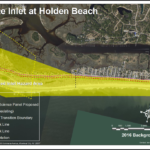
Inlet Hazard Areas
For more information » click here
.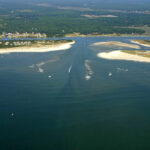
Lockwood Folly Inlet
For more information » click here.

Seismic Testing / Offshore Drilling
For more information » click here.

Offshore Wind Farms
For more information » click here
Things I Think I Think –
 Eating out is one of the great little joys of life.
Eating out is one of the great little joys of life.
Restaurant Review:
The Dinner Club visits a new restaurant once a month. Ratings reflect the reviewer’s reaction to food, ambience and service, with price taken into consideration.
///// June 2023
Name: Crave Cuisine: Italian
Location: 5900 North Kings Highway, Myrtle Beach SC
Contact: 843.213.0500 / https://www.cravemb.com/cravemb
Food: Average / Very Good / Excellent / Exceptional
Service: Efficient / Proficient / Professional / Expert
Ambience: Drab / Plain / Distinct / Elegant
Cost: $25 Inexpensive <=20 / Moderate <=26 / Expensive <=35 / Exorbitant <=60
Rating: One Star
Crave is an Italian restaurant that is located along Kings Highway in a small strip mall with inadequate parking. It is ranked #24 out of @575 restaurants located in Myrtle Beach. It has no ambiance at all, it’s as if a dive bar was converted into a restaurant. They have live music most nights which only reinforces the bar atmosphere. It’s a relatively small place with very limited seating. You are seated on top of each other, really don’t think they could have squeezed in another table. The venue is just too small for how popular they are. Although the food was decent it was not enough to overcome the other issues. I was very disappointed; it was not at all what I expected. They have plans to open another location in North Myrtle Beach sometime in July, perhaps this new location will not have these issues.
Crave will open a second location in Myrtle Beach. The new location of Crave Italian Oven & Bar will be at 7401 N. Kings Highway, according to a press release. It’s just a short distance from its other Myrtle Beach location at 5900 U.S. 17 N. The new location is set to open this fall. The family owned and operated restaurant also has a third location in North Myrtle Beach.
///// April 2024
Name: Crave
Cuisine: Italian
Location: 202 Hwy 17 N, North Myrtle Beach, SC
Contact: 843.258.9633 / https://www.cravemb.com/cravenorthmyrtlebeach
Food: Average / Very Good / Excellent / Exceptional
Service: Efficient / Proficient / Professional / Expert
Ambience: Drab / Plain / Distinct / Elegant
Cost: $25 Inexpensive <=20 / Moderate <=26 / Expensive <=35 / Exorbitant <=60
Rating: Two Star Crave’s new second location is superior to the original restaurant. That said, it was just all right, nothing special, so I have no idea why it’s so popular and gets so many rave reviews. Its full name is Crave Italian Oven & Bar with emphasis on the bar. They have two HUGE bars, one indoors and one outdoors, that were both very busy for Happy Hour. The Italian Oven is because they have a wood-burning New York style brick oven and offer a lot of pizza options. There are any number of other restaurants that are better, so in my opinion it’s not worth the drive.
Dining Guide – Local
Old places, New faces
Name: SmacNally’s
Location: 1045 B-Var Road, Supply NC
This spot that was once known as Betty’s Waterfront Restaurant before reopening in 2020 as LouLou’s Waterfront Restaurant. LouLou’s has permanently closed. They weren’t closed long before a new eatery was announced for the space. Owners of SmacNally’s Waterfront Bar & Grill are planning a second location for 1045 B-Var Road S.W. in Supply.
Popular Outer Banks seafood restaurant planning a second location in Brunswick County
For 25 years, SmacNally’s Waterfront Bar & Grill has been serving fresh seafood and burgers in Ocracoke. Now, the owners are planning to expand the brand for the first time, and they’ll be doing so in Brunswick County. Scott McNally announced that they’ll be taking over the recently closed LouLou’s Waterfront Restaurant on the Intracoastal Waterway at 1045 B-Var Road S.W. in Supply. “It’s time,” McNally said. “We’ve put a lot into this brand and it’s time to grow.” McNally has decades of experience in restaurants, and together with partners Tom Burruss, Matt Bacheler and Persell Morgan, they have more than 120 years in hospitality. One caveat is they wanted to continue with the waterfront restaurant tradition that’s close to local seafood. It made the Holden Beach area ideal. “At SmacNally’s we work with fishermen, and we have a fish cleaning counter right at the end of our dock. They bring it right from there, to our restaurant. It’s usually just hours from the ocean.” That dock-to-kitchen model is one they’d like to continue in Holden Beach. If that’s not possible, they still plan to work with local markets for the freshest seafood, he said. LouLous restaurant opened in fall 2020 in what was formerly Betty’s Waterfront Restaurant. The space has indoor and outdoor dining, a bar area and slips for boat parking. McNally said they hope to open the SmacNally’s in May. “Or sooner, if possible,” he said.
Read more » click here
Peach Cobbler Factory
The dessert chain that also has a location in Carolina Beach has opened a mobile unit (with delivery options) in Holden Beach. The menu includes a variety of cobblers, puddings, cinnamon rolls and other desserts at 3247 Holden Beach Road S.W.

Dining Guide – Local * Lou’s Views (lousviews.com)
Dining Guide – North * Lou’s Views (lousviews.com)
Dining Guide – South * Lou’s Views (lousviews.com)
Restaurant Reviews – North * Lou’s Views (lousviews.com)
Restaurant Reviews – South * Lou’s Views (lousviews.com)
Book Review:
Read several books from The New York Times best sellers fiction list monthly
Selection represents this month’s pick of the litter

FIRST LIE WINS by Ashley Elston
Evie Porter is a professional con artist whose specialty is insinuating herself into people’s lives, gaining their trust so she can expose their secrets.Evie develops feelings for her current mark and realizes that her latest job from her mysterious employer has become more personal and dangerous than planned.

LISTEN FOR THE LIE by Amy Tintera
Lucy can’t remember the night her best friend was murdered. Though Lucy was never charged, almost everyone in town still believes she killed her. It’s five years later, and Ben the moderator for the true-crime podcast “Listen for the Lie,” decides to investigate the unsolved murder of her friend Savvy’s death. Lucy returns home to solve her friend’s murder, working with Ben as he searches for the truth.
That’s it for this newsletter
See you next month
Lou’s Views . HBPOIN
. • Gather and disseminate information
. • Identify the issues and determine how they affect you
. • Act as a watchdog
. • Grass roots monthly newsletter since 2008

